#this finale's an interesting one from a storytelling analysis perspective
Text
truly ted lasso gave us the best gift a show could ever give a fandom: complete lack of confirmation or denial either way
#as well as the option of 'it was all a dream' interpretation for any bits of that final montage we didn't like#ted lasso#tbh the show didn't stick the landing as much as i expected it to#but it did so in such a way that we can go hogwild in this sandbox while remaining canon compliant for...most things really#certainly the bits i'm talking about here#namely: the roy-keeley-jamie situation#(which is good because their wrap-up was absolutely the weakest of the bunch)#(although i don't think they did anything particularly effective or affective with nate either#although nick mohammed did kill it in that scene with ted)#canon compliance is 0% a requirement for anything of course#but it does add a little extra something when you can slide something into the realm of 'feasible'#or at least when you don't have to evade or elide critical chunks of the actual story in order to tell yours#this finale's an interesting one from a storytelling analysis perspective#ultimately i would put the failures down to such careful writing over the rest of the season (and entire show)#that they were left with too much space to fill effectually and too little space to meaningfully#weave in any of the smaller outstanding threads#in combination with what i can only think to call.....An American Approach To An End#which is probably unfair of me but to me it felt there was something distinctly American about the lack of ingenuity#too focused on the meta-goodbye rather than effectively closing out the story#anyway#still Rotating#but also Rotating My Eyes
30 notes
·
View notes
Text
ooh I have so many thoughts on The Rat Grinders discourse okay
on the one hand, I think it's completely reasonable to be disappointed that there was no attempt from The Bad Kids to engage with TRG beyond just killing them as quickly and bloodily as possible, or no effort from Brennan to present that as an option. I agree that it sucks that these teenagers, who have been corrupted by rage crystals and are presumably being manipulated by authority figures, are being treated as irredeemably evil and therefore condemned to hell forever for their crimes - and I agree that it feels incongruent narratively, when a big arc this season involved 'redeeming' a corrupted goddess, and a key theme has been the power of utilising doubt to overcome rage. I also think it's a shame that Fig's past attempts to engage with Reuben were ultimately forgotten about and rendered useless (and I definitely got the impression that Emily herself was also frustrated about this).
however! I do also completely understand it from a gameplay, genre, and storytelling perspective.
firstly, mostly just as a sidenote, I think it's worth acknowledging that a lot of 'real-world' thinking and logic surrounding death and ‘redemption’ and the moral complexities of 'good vs evil' don't always work within Fantasy High or d&d. death is treated much more flippantly in a world where characters can and do regularly plane-shift to the very real and tangeable afterlives. it's harder to think of death as truly an end to someone's life when it is known for certain that those who die are actually continuing to live alternate lives on different planes of existence - and I think from a meta perspective this inevitably affects the way players think about killing NPCs within a story. no one is ever truly gone; they're just living somewhere else now.
additionally, in-universe, the prospect of dying or being killed is an accepted risk for those attending Aguefort. they're training to be adventurers, and as fucked up as it is, a key element of the universe and genre that this story takes place in is that people - including teenagers - die on adventures, and this risk is entirely normalised and considered unfortunate but necessary. it's one of those genre-specific tropes that you have to accept for the world to function. this is d&d, this is fantasy adventuring high school, teenagers have to save the world from other, villainous teenagers. it's every teen supernatural/fantasy drama. it's Teen Wolf. it's fucking Riverdale. as Brennan has put it before, "it's adventuring school. people die."
The Rat Grinders are not the heroes of this story - and what is so interesting about them, at least to me, is that they know that. there's a lot of excellent analysis of TRG as existing on a meta level even within the story; they're power gamers, they're XP farmers, they know they're NPCs; and this is the source of Kipperlilly's anger. Kipperlilly's rage stems from knowing that she is ordinary; that she doesn't have a tragic backstory, that she will never save the world, that she and her friends aren't a notorious adventuring party or 'found family' or anything other than regular. so she set out to become Not Ordinary by any means necessary - and if she and The Rat Grinders couldn't be the heroes, they had to become the villains. whether or not TRG 'deserved' to die or not is a moot point, I think. it's not about what they deserve. their story, and especially Kipperlilly's story, is a tragedy in this way; she was doomed by the narrative from the moment she started to write herself as the villain.
The Rat Grinders are, narratively, the Big Bads of the season; the Final Bosses of this game of d&d. this final battle is necessary to conclude the story in an exciting and climactic and satisfying way. it would simply not be as exciting, either for the players or the audience, if this season ended with The Bad Kids talking it out with The Rat Grinders and convincing them to switch sides. at the end of the day, this isn't a movie or a TV show. this is a game, being played in real time by real people who are improvising and having fun while collaboratively telling a story together. of course, the storytelling on this show is phenomenal - but it's never going to be able to do everything. they don't have a room of writers pitching ideas to write perfectly timed and paced scripts for character arcs and resolutions. they're a group of improv comedians playing a roleplay and combat-centric game together. they're playing d&d. they’re playing heroes fighting bad guys.
I do think there's a lot of valid criticism around rage and manipulation and who is considered worthy of 'redemption'. I just also think there's a middle ground somewhere between "The Bad Kids killing The Rat Grinders is awful and evil and bad storytelling and everyone involved should feel bad" and "haha suck it Rat Grinders fans, told you they were always evil". ¯\_(ツ)_/¯ idk. it's all love now. [smooch]
#MANY THOUGHTS HEAD FULL#fantasy high#fantasy high junior year#fantasy high spoilers#d20#fhjy spoilers#the rat grinders#darcey.txt
56 notes
·
View notes
Note
Would you want to do a recap of Stefania's amazing episode? I'd love to hear your perspective from a technical standpoint!
We’re doing it my sweet, enabling anon! Apologies for how long it has taken for me to truly organize myself and my thoughts with this.
There's gonna be two versions of this, because my jot noted, unhinged version is much more on brand for tumblr fandom space. But I only really realized that after writing out 3500 words of thoughtful film-school style analysis.
Below the cut, please find that version. And I'll post the fangirl edition that breaks down my thoughts scene-by-scene later.
The goal of Station 19’s 7x04 ‘Trouble Man’ was, put simply, to just fucking break everyone. Each one of the characters on screen needed to, or at least appear to, reach rock bottom by the time the credits rolled. Which is, honestly, why I love that they chose Stefania Spampinato as the director for this one. If you’ve seen any of Stefania’s directing work (you can view Zita Sempri here), you know that her strength (and interest) lies in emotional storytelling. I think, because Peter Paige and Stefania have clearly had a mentorship/friendship relationship, that he recognized this episode would be the type of story she would and could excel with.
(This differs greatly from what they chose for Danielle Savre last season, whom we know describes herself as organized and a Type A sort of person. They played to her strengths, as well, and gave her a challenge with an episode that would require a lot of technical organization and strong leadership for such a large on-location scene with so much additional equipment.)
As fans, we all lucked out with Stefania’s episode because it didn’t harbour the additional technical challenges that Danielle’s did and so the showrunners didn’t decide to lighten Stefania’s load by writing her out of most of the episode. (I’d wager, too, that all of her scenes being strictly with Danielle and their rapport with each other also supported that case.) I’m honestly so proud and happy for her (and Danielle) that she was able to have the best of both and experience the feeling of directing herself on screen, alongside an acting partner that she trusts and has worked with for so long.
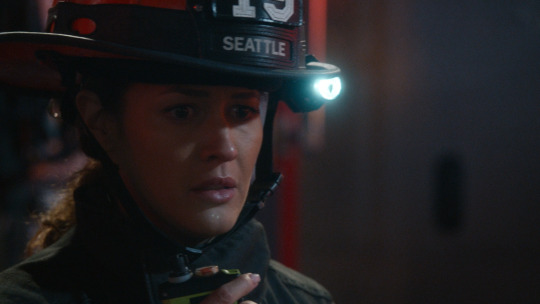
So, the story is set up as a version of the 7-Point Plot structure (or maybe a Save the Cat, if you’re fancy) and we begin with Andy at what we will later discover is her rock bottom moment. Because we already know the formula of first images in the show is a lot of quick cuts, Stefania made a really excellent choice here in how she shot this specific moment to keep on brand. What she could’ve done is a bunch of different angles of Andy and hoped that when they got to the editing room, there was enough there to avoid the dreaded jumpcut – or enough to lean into a purposeful jumpcut.
[A jumpcut is when a final edit showcases two shots back-to-back that are not precisely the same but are similar enough to cause a jarring effect for viewers. For example, a shot of a person’s face head-on, followed immediately by another shot of that person’s face at the same level with both of their eyes still visible. To make that not jarring, you would want the next shot to be from a lot lower or higher, or directly from the side or behind. Jumpcuts can be used effectively to show the passage of time, for example, such as in Vic’s hospital room scenes or in the bunk room after Andy’s assault, but they need to be proven purposeful by happening at least three times or more in a row.]
Instead, this moment was shot several times with a dolly around Andy. As the momentum of the start of the episode builds, so does the speed with which the shots cut between each other. This was such a cool, smart way to create tension right off the bat and I think it worked really effectively as a hook for the episode.

Truthfully, I think this choice was the biggest faux pas of the episode. Hear me out; this doesn’t match the Station 19 font. It doesn’t lend to the theme that’s already been set on the show regarding text on screen. There are no other episodes in this season (thus far) that have text on screen as part of the storytelling… it was just all off for me.
In my ideal world, this would’ve been exactly the same text style as the show’s logo (perhaps even underlined in the red) and they would’ve pulled something a la Alias, where the scene appears through the text. (Or just stuck it over a shot without the black, like they did with the rest of the time updates???)
This will just forever feel like it was tossed in during editing as a placeholder and then accidentally left there. Maybe they didn’t have enough money for someone to come in and do text editing? I don’t know. I need to stop thinking about it eventually or I’ll drive myself crazy.

But moving on! There were a lot of fascinating and technically challenging moments right from the beginning of this episode. I love that Stefania chose to visibly have the trucks returning to the barn (something she spoke about here) because it isn’t something we’ve really seen before, as it would be challenging to shoot. I’d love to know how they balanced how much ND filter would be needed to block out the light coming in through those open doors without losing visibility on the trucks and the characters. This would’ve been a full team effort to set up this sequence, especially considering it’s (nearly) a oner from this moment until 30 seconds later, when Vic tells Theo she doesn’t care that he kissed Kate. (There is a tiny cut while Beckett is walking across with his axe that they hid really well in their editing, but is still technically a jumpcut.)
[A oner or one-shot is a term to describe a scene filmed in a single shot. They are very, very difficult and time-consuming to do as everything must be synchronized and rehearsed and one little mistake can send you all the way back to the very beginning of the scene. The first one I ever remember seeing was Miley Cyrus’ music video for Start All Over in 2007. Director Mike Flanagan has killed it with two incredible/epically long ones in The Haunting of Hill House episode 6 and Midnight Mass episode 2. There’s also a great one in season 19, episode 12 of Grey’s Anatomy, which was directed by Kevin McKidd, and which Stefania herself was in. If you wanna know more about oners, hit me up as I have a plethora of links and behind-the-scenes information regarding how they’re done because I think they are sooooooo cool.]
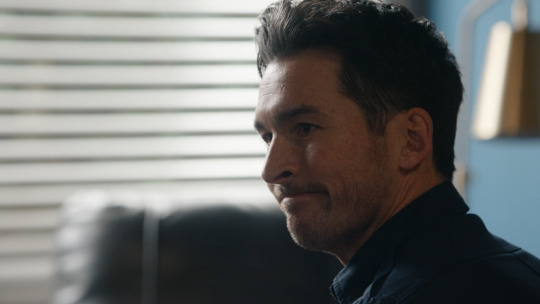
I just gotta say, I laughed out loud at this moment. Solid editing aligned the whip of Travis’ head with the end of the backing music that was hilarious and so on brand for the show. Something like that wouldn’t have been planned on set, most likely, and would’ve occurred instead in the editing suite. But I so dig that the choice was made because it’s perfect. Kudos to Stefania if she had any involvement with it other than saying ‘keep it’. (I’m presuming the editor, Eli Nilsen, is who I have to thank for it.)
Also, the movement of this scene was gold, which is entirely up to Stefania’s direction. I loved the switch of Travis from the chair to the couch beside Vic. There was so much great coverage, the pans from outside the room were beautiful; all-in-all I thought it was a really excellently executed scene, from a purely technical standpoint.
In Stefania’s directing interview with Shondaland, she spoke about starting with more wide shots at the beginning of this episode and gradually getting closer and closer. Which I love, of course, as an artistic choice. What I found most consistently, however, was a subversion of the TV formula of establishing shot to character shot.
To break that down, most shows setup new scenes with a wide, establishing shot of the new location (think Friends, where you see the outside of their apartment building before any scene with the characters in their apartments – this is very sitcom) before going to the characters.
A lot of the scenes in this episode, though, start with a closeup of the characters before moving to a wider shot of where they are. The scene with Maya and the drill, for instance: we start on that drill and the window frame before we pull back to see its her, that she’s in the nursery, that there are boxes stacked up, that Carina is trying to change Liam’s diaper, etc, etc. I think that choice lends a lot to the emotionality of the episode and is really intelligent editing, but also really intelligent coverage of each section of the story on set.
Specifically, my notes said: “It keeps you pulled into where the character is at mentally, emotionally, versus where they are physically.”

As we move into Maya and Carina’s house, I have so much to say about colour. This shot is a great spot to dive into all the tiny little details. I will say, I don’t know if Stefania would’ve had as much say regarding colour and set design or dressing on a singular episode as she would if she were directing a film. But! Whoever made choices for this was so, so on.
Just… look at this for a moment. Carina goes with this house. Everything in this shot blends cohesively. The yellow of the counter and backsplash is balanced with the yellow clothes in the basket atop the dryer. The blue of Carina’s jeans pulls the blue stripe from the dish towels hanging on the stove. The pink of her shirt goes with her shoes and the pink flowers on the wallpaper around the window. Everything belongs here. Even the stripes of Carina’s shirt are reminiscent of the Carina we first met in Grey’s Anatomy six years ago.
For me, this lends so much to the dynamic occurring between Maya and Carina in all these scenes. While Carina fits visually, Maya still appears just slightly off – the red of her sweater doesn’t quite match anything, her jeans are darker. As she talks in the kitchen with Carina, she’s cast more into shadow than Carina is.
My inner film theory geek was rejoicing at all of these choices, simply because they’re a prime example of the importance of all departments involved in film and television production. Big ups and shoutouts to the production designer (Sandy Getzler) and art department on this episode (Carissa E. Mitchell, Jorge Rodriguez, Alisha Rothman, and Kennedy Taylor) and the costume department (Meesh Daranyi, Veronica Teong, and Cleo Trifonidis).

There’s a lot of really, really strong framing choices in this episode. I could (and might) rant for a bit about all that. But this scene struck me, both from a writing standpoint and the execution.
Choosing to do this call with voiceovers not only saves so much money and time, it also builds a ton on the emotionality of this moment for all of these characters. I love that Stefania brought in a bit of that constant moving energy we know and recognize from Grey’s Anatomy here, too.
I screenshot this specific frame because we have this moment where we see so much of what we know of Chief Ross – her power, her importance, how put-together she is. And then the shot pans up to her face, as we’re listening to these awful things happening on the other end of the radio and it’s her breaking point. This scene is her rock bottom – her inciting incident where she has to, ultimately, decide to act or react. I’m hopeful, as a viewer, that this is telling of her story for the rest of the season being a battle with the mayor for funding.
Anyways, I love Stefania for this framing. I love the panning. I love the movement. I love the cuts and all the angles. I love that she chose the lenses she did, cause girl clearly loves a short depth of field. Just, she knows what she’s doing and I am here for it.

Let it be said that the pan shot of Andy and Beckett in the front seat of the truck, which is the start of this scene, is probably my favourite shot of the episode. It made my breath catch the first time I saw it. Toss in the exquisite, gut-wrenching coverage of the bloody boot print and the pan over Herrera written on Andy’s turnouts and it’s all chef’s kiss. Directing Queen Stefania is coming for the jugulars with the emotionality of the episode by this point.
Especially considering, this boot print is not important to the story at all – this is entirely stylistic. There is one shot, however, where she covered the Jaws of Life being placed in the truck after a call and that was very important to the story.

I wrote a lot about this shot, so I’m going to talk about it, too. I think it was a cool choice to start this scene with a head-on closeup of Theo. From a technical standpoint, a shot like this is challenging to do because you want to see more of the bathroom behind him, to help establish the location, but the lens needed to make that possible distorts faces a bit when it’s too close.
As a viewer, I found that here and when you notice it, it’s a little off-putting. Especially considering everything else in the show is shot true to reality. (One other great example of a time when shot angle/framing/lens didn’t align correctly for my eyes is in season 3, when Maya and Carina are on vacation together and they kiss before going to the pool.)
I will say, the unnervingness of this distort might have been intentional. Throwing viewers off-kilter is a great way to build emotionality and unease. It just sticks out here, because it doesn’t really occur anywhere else. (She used the same framing later in the episode for Vic, too. I think it was less unsettling there because Vic was moving, whereas Theo was just looking at himself.)
Gold star at the end of this scene for the continuity department – a department of one, Sharon Cingle on script supervision – for making sure the shower curtain was left open that little crack to make the closeup pan of Ben make sense. How many times can I say I loved a shot?
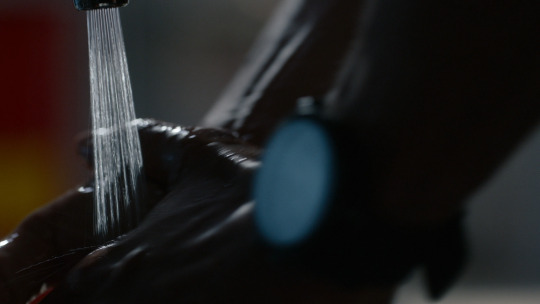

My first note for this scene says: “Can’t say Stefania doesn’t love an ECU and a rack focus… beautiful establishing for this scene from the hands to Beckett’s feet.”
[A rack focus is when the focus of a shot visibly shifts from one point in the frame to another, typically from closer to further away or vice versa. It is more obvious when done with a short depth-of-field, which means a smaller amount of space that is in focus at a time – such as in the shot above.]
This episode was a lot of fun for me because it felt like Stefania was playing with parts of the set we haven’t scene before. The communal bunk room, for starters. A different angle of the station, where you could see the balconies outside and houses behind the building. And this moment – with the sink and the back of the barn. I can’t even imagine how tricky it must’ve been to maneuver and set up shots in such a tight space.

But she did it, of course. We’ve got this gloriously tight angle of Beckett’s face, where we could watch the tears roll down his cheek. And that pinprick of light is visible in his pupil, which you want present when lighting human faces for on screen.

And I mean, the levels here are so interesting. There’s rule of thirds happening in these shots. There’s balance of characters in the framing. Most importantly, there’s something unspoken happening with the swap of power. This is Beckett’s breaking point in the episode – he’s literally sitting at rock bottom, the lowest he can get in the station. With Sullivan, who was once his lesser, above and looking down to him. That’s powerful body language – you’ll find a lot of people feel a need to stand when they’re asserting their authority in a situation, trying to gain the higher ground. (It’s almost like this thing burned into our DNA from years of building castles on hills and shit.)
But this is a turning point in the episode for Sullivan, too. He once tried to help Beckett and was refuted and now he’s being faced with a choice to either extend the offer again or turn away from the problem. I like that his decision is echoed in helping Beckett up off the floor. Kudos to Stefania for staging it this way.

Now’s probably a great time to dive into Stefania’s framing choices, cause she did some crazy beautiful stuff. My notes say: “Queen of the two-shot!” here. It’s fascinating to me how she used reflections in this episode – the first couple times we see Andy get out of the engine, we see a flash of her face in the side mirrors before we actually see her face-on. She also played with the mirror in the bathroom with Vic and Kate’s confrontation.
[A two-shot is when two characters are visible in the same frame.]
But, at least for me, the two shots and reflections work because she consistently picked lenses with a shorter depth of field. The rack focuses between characters make these shots so much more visually interesting. There were so many of them that I nabbed in my screenshotting that spoke to me or got me excited or were examples of a really good eye.
Exhibit a, b, c:



And while we’re talking about two- (and three-) shots, let’s discuss foreground. Because I was so struck by a few shots, specifically because of the choices of things Stefania kept in the shot in front of the characters.
From screenshots already above: the wall outside the kitchen in Maya and Carina’s house and the engine with Beckett’s feet behind it. Please see exhibit a, b, c, d for more that struck me:

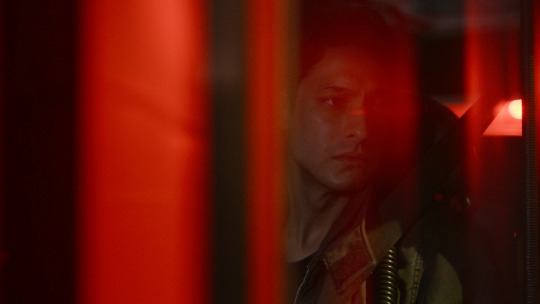


I don’t know how to explain this really technically, my dudes, but it’s so visually pleasing. It’s so interesting. It kept my eyes so invested in what was going on. I love when directors give us a chance to really explore the set design and feel really immersed in the location with characters. There were so many times this episode where Stefania chose a framing through a window – from inside Maya and Carina’s house while they were outside, through the blinds into the gym and Andy’s office and the conference room, into the engine and the ladder truck through the windshield. I can’t sing enough praises about that.


Let’s wrap this up with Andy. There are two scenes in this episode where she’s having important, serious conversations with men that she holds authority over. And Jaina is short, especially when next to Boris and Carlos. A different director might have chosen to frame these scenes in a way that made Andy appear smaller than these men – but not Stefania.
There’s a really conscious effort here to keep Andy’s authority visually present – the shots pull in closer on her and the guys’ heads are cut off. She doesn’t look shadowed by them and their height because of this framing. It makes it very, very clear that this is her story and she is the most important character in the room.
And honestly, I think that’s a great example of this show – and Stefania’s direction – not being a male gaze interpretation. There is no passivity to the way she has shot the women in this episode. They are not presented as weak or small or not in control, even when the emotionality of a scene is overwhelming. Andy, Ross, Vic… they are very human in this episode, even when they’re crying. For me, that’s what makes the entirety of the work here so strong.
I am endlessly proud of her and this episode. One of the best of the show for me.

You go, Stefania Spampinato.
#janelle's asks#film and television production#film school analysis coming in hot#thank you for this anon... I had fun#station 19#director stefania spampinato#station 19 spoilers#station 19 season 7 episode 4#episode analysis
6 notes
·
View notes
Text
Exploring the Tapestry of Human Sexuality: A Review of "Kinky History"
Kinky History
In the vast landscape of human history, few topics have been as misunderstood, stigmatized, or hidden as sexuality. Yet, it's a fundamental aspect of our lives that has shaped societies, influenced cultures, and driven much of human behavior. The book Kinky History: A Rollicking Journey Through Our Sexual Past, Present, and Future offers an eye-opening exploration into this often shrouded part of our collective story. Written with both wit and scholarly rigor, it delves into the evolution of sexual norms, taboos, and practices across different cultures and epochs, offering readers a richer understanding of human sexuality.
The Author’s Approach: Blending Humor with History
One of the most engaging aspects of Kinky History is its unique approach to storytelling. The author, Esmé Louise James, masterfully blends humor with historical analysis, making complex and often sensitive topics accessible to a wide audience. The book is not just a dry recounting of facts and figures; it’s a lively, sometimes irreverent, narrative that invites readers to reconsider what they think they know about human sexuality.
The author’s use of anecdotes and real-life examples adds a personal touch to the book, making the subject matter relatable and engaging. Whether discussing ancient Greek practices, Victorian prudishness, or the sexual revolution of the 1960s, the author manages to connect these historical events with contemporary issues, showing how the past continues to influence the present.
A Journey Through Time: The Evolution of Sexual Norms
Kinky History takes readers on a chronological journey, starting from ancient civilizations and moving through to modern times. Each chapter focuses on a different era, examining the prevailing sexual norms and practices of the time. The book provides insights into how sexuality was viewed and regulated in different societies, from the liberal attitudes of the ancient Greeks and Romans to the more restrictive mores of medieval Europe.
One of the book's strengths is its exploration of how sexual norms have been used as a tool for control. Throughout history, those in power have often dictated what is considered acceptable or deviant behavior, using sexuality as a means to maintain social order. Kinky History sheds light on these dynamics, revealing how sexuality has been policed and regulated across different cultures and time periods.
The Present and Future: Where Are We Headed?
While much of the book is dedicated to exploring the past, Kinky History also offers a thoughtful analysis of the present and future of human sexuality. The author examines how modern technologies, social media, and changing cultural attitudes are reshaping our understanding of sexuality. The book also touches on current debates around issues such as gender identity, sexual orientation, and consent, providing readers with a nuanced perspective on these complex topics.
The future of sexuality, as presented in Kinky History, is one of increased openness and diversity. The book suggests that as society continues to evolve, so too will our attitudes toward sexuality, moving towards a more inclusive and accepting world.
Final Thoughts: A Must-Read for the Curious and Open-Minded
Kinky History: A Rollicking Journey Through Our Sexual Past, Present, and Future is more than just a history book—it’s a conversation starter. It challenges readers to think critically about their own beliefs and assumptions and recognize how history continues to shape our present-day attitudes toward sexuality.
Whether you’re a history buff, a student of human behavior, or simply someone curious about the evolution of sexual norms, this book offers valuable insights and a fresh perspective on a topic that is often overlooked. With its engaging narrative and thought-provoking content, Kinky History is a must-read for anyone interested in understanding the complex tapestry of human sexuality.
So, if you’re ready to embark on a journey through time and explore the fascinating history of human sexuality, Kinky History should definitely be on your reading list.
1 note
·
View note
Note
Hey! So, I was wondering...will you elaborate on the memory of spears that the Reader had involving Sektor?
And if it isn't too much...can you please share some writing tips??? 🙏🙏🙏🙏🙇
Your storytelling is superb, (especially in the bi-han's perspective chapter) and I'm sitting over here wondering like...how does she make it flow this nicely???
Honestly, I mean it. Thanks in advance if you do.��
Hello! I just finished skimming through my story to answer HHAHA. I'll admit, I get forgetful about what happens in my story and I usually have to like briefly skim my published chapters whenever I'm writing the next one
So, the 'certain memory' was referring to a spear interaction with Sektor in chapter Daggers, Spears, and More Smoke. It was a fun Easter egg and I wanted to incorporate how Sektor and Cyrax have different opinions regarding how the Lin Kuei should function WHICH will link back later into the story... waayyy later. Reader already interacted with Sektor once and finally met Cyrax later on which sets up some stuff that I won't spoil :D
I really like it when stories/plots link back to stuff that have already happened so I tend to do that... not even tend to I consistently do that in my story. I think it also serves as a great reminder for what has already happened in Kombat Hearts since I post like pretty much monthly HHAHAA (I'm planning on posting two chapters at once when i next update, or really closely because of how the plot is right now)
Thank you so much for the compliments!! Your words are confident boosters and readers like you motivate me to continue writing (*^▽^)/★*☆♪ I'll explain my writing process and mention some tips (I hope thats okay!)
I think my best chapters so far are Is It Getting Cold in Here? and En Passant (which is a title that has a hidden inference to reader's current relationship with Bi-Han!). For specifically En Passant and Bi-Han's background, what I did was I briefly planned out what I wanted to happen between reader and Bi-Han (ie how does this affect them?). I actually do short character analysis profile sheets of the different love interests on Notion — I'd share but it contains like all the spoilers possible for my story.
Using the little information we were given about Bi-Han's past from the game, I built on it by jotting down what I think would cause Bi-Han to eventually cause his betrayal. For me, it definitely stemmed from his father figure — to me, his core reason for becoming so cold was because of his father's cold treatment that burned out Bi-Han and to cope with the burn-out, he froze his heart and feelings so he could convinced himself that all his suffering was so he could surpass his father and reform the Lin Kuei (and he got to the reforming belief after making the correlation that the Lin Kuei was essentially dying out because his father was becoming more lax but was still making Bi-Han complete hardcore regimes. Why does Bi-Han have to spill blood over his training sessions whilst the actual Lin Kuei assassins sit idly waiting for the next mission?). He's the type to make sure that he's suffering for a reason, everything he does is for a reason. I think the past of Bi-Han explains the majority of my thoughts so I won't go too deep into that.
In terms of technicalities when I was writing the perspective, I made sure to add information that I could reuse later into the story, and I had to make sure I re-mention information I already said in the previous chapter to make sure there's no plotholes (or at least... I think so :D). I also had to consider the different connections that Bi-Han had and how they affected eachother. I had to consider domino effects too and how it would eventually affect Bi-Han's development. Basically, everything has a meaning. I really love story plots that have intricate meanings, or even several meanings which is why my work tends to be quite descriptive
At the start of writing Kombat Hearts, it was actually my first time dedicating myself to writing violent, pure action-based fight scenes. I had to search up how to write fight scenes, and one of the tips said to not make fight scenes too long - a page will do (size of a standard book page so I kinda had to go well that seems long enough on Notion). I think that really helped me because I do understand how fight scenes can been really dragged out and boring. It was difficult at first because Mortal Kombat is fulllll of fighting but limiting how much fighting I put in my chapters allow me to focus on other stuff (e.g. how the characters are feeling and how the aftermath rolls out). To write fight scenes, I'd actually watch a short video on insert character gameplay and incorporate canonical moves. Highly recommend if you're stuck
Okay, to make sure I answer your question I'll actually say some tips :D
I tend to write my chapters a bit at a time (mainly because I don't really have the time to sit down and write it in one go) which allows me to have mini breaks in between and recheck my work with fresh eyes. I think leaving your work for a day is great because you give your whirring mind a break and you can look back at your work with a different perspective
Imagine yourself in your reader's position. This is what I tend to do when I figure out the plot of each chapter. As a reader myself, I know we want action and the drama and the juicy stuff, and if you're like me who posts monthly, you have to consider how your readers would feel if they waited for a month only for a chapter to be super meh. IMPORTANT NOTE if you're like me who's doing it for fun and for free, be indulgent! Yes, consider your readers because your readers are what allows your fanfic to be noticed and to be loved, but you're (presumably) writing the fanfic so you yourself can fan about the characters. Honestly put your love into your writing and people can instantly tell and appreciate the effort that you put into fleshing out beautiful stories for anyone to read
Do character sheets, doesn't matter how detailed it is. It helps you stay on track and serves as a reminder for what you want to write. I tend to accidentally go off the rails in my plot and at one point I'm like... hold on this will mess up my plot and I have to go back to remind myself what I want to happen and why
In terms of writing styles... I think a large reason why I write like that is due to the media I consume. I really love poetic material and shows that have depth to them. I just finished Hannibal today and I absolutely LOVED some of the hidden meanings in the episodes. Before Hannibal, I watched the entirety of Adventure Time and I loved the different meanings and life lessons behind the show/Finn in the later seasons. I think. writing styles largely come from how you absorb literature/story plots.
I'll also add on that my writing style came to me somewhat naturally and I have a strong affinity English and social sciences (I'd add humanities but I don't particularly enjoy history). But, with tons of practice and personal passion I developed my skills. I don't remember who said this, but it's like building an art skill. You have to train your eyes to recognise what you're drawing looks off and how to improve it. For me, when I'm writing, I make sure that what I'm writing looks right to me aesthetically
To be honest, some of the plot in my story comes from personal experience/my experience of the world and with other people. I use this story as a way for me to express my feelings sometimes and it is cathartic (e.g. Bi-Han's whole thing). I think it gives the story more realism and also I hope my story is cathartic for people who may have experienced something similar
That's most of the tips I have so far — i probably have more but i need a prompt to think of more xD. If you have any more questions or have anything specific you want to ask, please ask!!! It's 23:18 for me by this paragraph and I think I've been typing for an hour, but I loved every minute of it!!!! Thank you for the question and the support :)) if you need any help, feel free to drop me a message and I'll try to respond ASAP
#THANK YOU FOR THE SUPPORT#It means the world to me fr#kombat hearts#its so late for me i wont know how coherent this is until tomorrow HHAHA
1 note
·
View note
Text
Blog 6 the final one
For this blog, I just want to explain how awesome this class was AF 112 at UCLA with Professor Due. It broke down the black horror genre in so many ways that even though I’ve seen certain movies required for the course, I didn’t understand them until we talked about them via lecture. From Blacula to Us, to Get Out, these films are leaving class with a better understanding of even the history of the genre itself and its origins. To even understand creative literature and some of the shows I watched when I was young like Tales From The Hood, I understand now why it was scary, it was because of the social commentary it was built off of and the reality of circumstances we as black face in the world. I loved how my professor is an actual professional in the film industry and how she creatively writes her own books and movie and short film ideas, who better to break down other works than someone who comes up with her own? This class was refreshing and changed my perspective on how to break down films specifically in the black horror genre of movie-making and storytelling. I will miss the experience truly and also I would also like to state I loved the final, being able to write my own short story which is something I didn’t know I was capable of doing. I felt I did a pretty good job, especially after all I learned in this class regarding what makes an interesting film and story line, including character analysis and other aspects that make movies in black horror and literature interesting regarding issues that we can relate to. I would also like to state I enjoyed the fact that my professor liked Jordan Peele’s work as much as I did. I’m a happy student hopefully moving on with a good grade from this class.
0 notes
Text
Online Magazines: Transforming Journalism

In the digital age, online magazines have emerged as powerful platforms that are revolutionizing the field of journalism. With their unique blend of multimedia content, interactive features, and timely updates, online magazines are reshaping the way news is presented and consumed. This article explores the significant impact of online magazines on journalism and how they are redefining the media landscape.
Dynamic Multimedia Experiences
Online magazines, such as the renowned "Best Entrepreneur Magazine," offer a dynamic and engaging multimedia experience that sets them apart from traditional print publications. These magazines provide readers with a rich and immersive storytelling environment through the seamless integration of high-quality videos, captivating images, and interactive elements. This innovative use of multimedia enhances the audience's understanding and connection to the news, enabling them to delve deeper into the stories that matter most to them.
Global Reach and Instantaneous Updates
One of the most remarkable advantages of online magazines is their ability to reach a global audience within seconds. Unlike print publications, online magazines can disseminate news instantaneously, breaking down geographical barriers and enabling readers worldwide to access the latest updates. This real-time nature of online magazines fosters a sense of connectivity and ensures that readers stay informed about events as they unfold.
Interactivity and User Participation
As the leading platform in its field, the "Best Online Magazine" empowers readers by offering various interactive features that encourage user participation. With accessible comment sections, engaging polls, and seamless social media integration, readers can actively engage in discussions, voice their opinions, and contribute to the narrative. This interactive element bridges the gap between journalists and their audience and fosters a sense of community and collaboration within the news industry.
Personalized Content and Tailored Experiences
Online magazines employ advanced algorithms and user data analysis to deliver personalized content and tailored experiences. Readers can access articles that align with their interests and preferences through targeted recommendations and customized news feeds. This level of personalization enhances the overall user experience and ensures that readers are presented with relevant and meaningful content.
Amplifying Diverse Voices
Online magazines have emerged as powerful platforms for amplifying diverse voices previously underrepresented in traditional media. By providing a space for marginalized communities and lesser-known journalists, online magazines contribute to a more inclusive and pluralistic journalism landscape. This democratization of news allows for a broader range of perspectives and promotes a more comprehensive understanding of the world.
The Final Note
Online magazines have undoubtedly transformed journalism, revolutionizing how news is created, consumed, and shared. As readers increasingly turn to digital platforms for their news, the influence of online magazines will continue to grow, driving innovation and redefining the boundaries of journalism. So, whether you're an industry professional or an avid news consumer, it's clear that the rise of online magazines is a trend worth following. Therefore, stay ahead of the curve with platforms like "The CEO Views," where you can explore the best online news magazines seamlessly and engagingly. For detailed information, visit their website- Theceoviews.com.
0 notes
Note
Been reading some of your blog and I'm trying to understand something. Are you saying that Jaune will have unconditional love for Cinder upon saving her? How is he supposed to love her by then? Or maybe I'm misunderstanding your meaning. What are you defining as unconditional love? and what would compell him to feel it for Cinder? Is there a way for him to learn about her backstory before seeing her again?
I'll try my best to answer. These are involved (and interrelated question) questions which are at the heart of the pairing.
Is there a way for him to learn about her backstory before seeing her again?
I've discussed this under my V9 speculation tag, but I think that visions could come into it (Joan of Arc). On the other hand... I think the set-up for only us the audience knowing the full tale of Cinder's backstory means that when she chooses to share it (not pressured) with someone it will be a big deal.
So I don't know how that relationship will necessarily play out beat-for-beat, but no one can predict that sort of thing. I can only intuit it.
At the very least, I think that even if Jaune has supernatural means of figuring out what happened to her, it's not an instant change of opinion. The path I would want on that front would be for him to only have some idea, not to know it in its entirety. It's intensely personal and vulnerable and no one else knows about it except Cinder (or Watts to mock her, which is very very weird and implies Salem has told her minions about Cinder's background, which is bad).
So, you've got to be prioritising character needs and an interesting way to convey information. In my opinion, Cinder telling it to Jaune (in whatever detail she's able to) is going to be more interesting than Jaune seeing it (and us with him)... on the other hand, you could do what I do in my fanfic and keep his visions a secret. If there's something nondescript plagueing him, it could be anything, but if it's something only we know, the reveal could actually be really interesting. I don't know if they're going to do that, it's too speculative, but it is the economic storytelling I would want to expect.
The idea here is that Joan of Arc embraces her visions; for Jaune, because his Joan of Arc mirror tonally is reversed, I think they should trouble him.
On the other hand, I just conferred with my Best Mate about this post because I had to cover so much in this post, and she suggested - given the fact Salem has already dobbed - that she tries to discredit Cinder to the heroes (or Jaune in particular...) in a way that backfires and instead makes her sympathetic. This would also be part of the set-up for getting Salem's perspective on things too. Either way, there are a lot of interesting ways to go about it. The visions is something that made sense to me just because I'm expecting more Joan of Arc to figure in, and the Fallen Place.
I also just want to add in a footnote that Jaune has already seen Cinder's arm pain her (in the finale of V8) so it's probably not even that complicated. He has some idea of Something Being Bad.
What are you defining as unconditional love?
I'm not sure why I've now had two anons confused with my using the term 'unconditional love'. That's genuine curiosity, I had no idea it was a point of contention. It's unconditional because the conditional (platonic) regard Rhodes had for Cinder was... conditional, the same as every other relationship Cinder has had; they all want something from her (and in the case of Emerald she encouraged it), and when she transgresses it she's punished (if she's even loved at all in the first place). I'm not saying Cinder is blameless, because she has used this transactional approach herself (and been confused when Emerald expected it back), but this is exactly why I would want to see it specifically addressed.
I need to convey exactly how serious it is that The Truth that plays in Midnight, V8:E6, says: 'The truth is that nobody's ever loved you.' True love, real love, unconditional love, is a major deal in Cinder's story. She's been denied it.
If Jaune's in love with his once-enemy, it's going to be high-stakes unconditional love. They've seen the worst of each other and also the best and accepted both (and it's vulnerable). I have written about unconditional love in a separate post but I can't find it, but I would say that love can co-exist with other complicated feelings and it's not an on and off switch. Not universally by any means.
In a story like this exploring emotional ideals, and most importantly magic (and magical transcendental potential), then I would be expecting the romance to be magical. You might not be able to believe in unconditional love, but I would believe these characters could and would unconditionally love each other, especially after all they've been through (even, yes, as a consequence of each other. I think the ironic balm is a feature, not a bug:
JOSEPH CAMPBELL: Right. That’s a very mysterious thing, that electric thing that happens. And then the agony that can follow, which is that which the troubadours celebrate, you know, the agony of the love, the sickness that the doctors cannot cure; the wounds that can be healed only by the weapon that delivered the wound. […]
Well, the wound is the wound of my passion and agony of love for this creature, and the only one who can heal me is the one who delivered the blow, you know.
BILL MOYERS: So we often hurt most the person we love, and heal the hurt by the love that hurt.
JOSEPH CAMPBELL: That’s something like that, that’s the paradox of the job.
(Emphasis mine, source is Power of Myth, Episode 5).
Unconditional love is no-holds barred. In the case of Cinder, by the time it's developing - whether it's textual but only subtextual - that kind of love where you transgress the Side of Good and help someone everybody says is too far gone is set-up for it.
From this perspective, unconditional love isn't just about my ideal of love, it's about what the characters need and what is necessary to help Cinder and for Jaune to be in a transformational and unique position narratively.
Well, actually, let's go even further: it's not just a character need, it's a story need.
Are you saying that Jaune will have unconditional love for Cinder upon saving her? How is he supposed to love her by then?
I have not said Jaune is going to save Cinder recently (and if I have, consider it recanted) and instead I think he's going to help her. There's a marked difference in passivity - I also think it diminishes the impact the whole thing has on Jaune's character. For that matter, I think this is the type of distinction the show itself would make (and is part of why it redeems Ozlem).
I think it's funny that when I get asks on this topic it's never about how Cinder is supposed to love Jaune. I'm not sure if it's just interest in Jaune motivating it, but there has historically been the implication that of course Cinder could love Jaune, because he's not broken or villainous like she is. I think this misses the mark on how important Cinder's character is for Jaune just as much as the reverse. It's intertwined with his purpose in the story, yes, what he's made for, yes, that he can help someone who needs it, yes, but also that Cinder would just want Jaune for who he is, not what he has to be.
I think that it could evolve by then, yes. Here's a post where I discuss it in more depth.
I've written my fanfic and my version of it, but when it comes to canon speculation I don't know what it's going to look like beat-for-beat.
I am primarily a fanfic writer, and the emotional answer to this type of question is something I'd rather answer (or have answered) in the literary form. My analysis posts are for my own personal satisfaction and to ground my fanfic.
I think by the time they meet over the Relic (I'm sure you've read those posts) it won't be a violent confrontation. I've written a post here that discusses canon speculation in more depth of their relationship that is more recent than the others. From a character perspective, I think that there's this interesting idea that were it not for the fact they're enemies, they'd get along winningly. There is some sense of fateful unfairness about it and maybe even surprise. I can't describe to you the parallels of their characters or the joy of what them interacting romantically would be, because that's emotional, and asking 'what would compel him' is hard to answer because I think that the fact there's more depth to this woman he once hated is enough to set up intriguing. I do think that they both, as characters, would make the most sense together, but also bring out the best characteristics of each of their characters (and make them make more sense to the audience). Imagine how swimmingly well Cinder's plotting would go with Jaune's lol.
But that is once again trying to appeal to your emotional senses, and it seems like you want structural answers. I believe the only way to sensibly understand their character arcs in read in relation to each other.
Where I find analysis dissatisfying is because one of them is often neglected. Both of them are nobodies who would see something special in each other. There is also that sense of irony in their characters and character needs. Jaune is someone who would take her with him and not leave her behind. Cinder is the Fall Maiden he can help. It intensifies conceptually from that point, given that these address deep wounds in their characters... but there is also that element that she hurt him most of all. Either he can kill her or he can see what's really there, and to see with eyes unclouded by hate (Princess Mononoke lol) is a major theme of R/WBY. Basically doing what no one else has managed to ever do. Like Ozlem, Ozma didn't save Salem from the Tower for her hand or riches or glory. I think the romantic consequence of Knightfall is after she goes with him, or when she does, which recontextualises all prior interactions slowly building it up. R/WBY likes its slow burn already.
I can predict the broad beats using narrative structures (Jung and the monomyth) or major foreshadowed events (Jaune and Cinder meeting over the last Relic, the Fall Maiden's Relic) or discuss what Cinder's redemption arc should look like - which is linked to Knightfall - but I can't tell you how they decide to write it beat for beat, beyond how it reflects other canon romances. Blake/Yang becomes textual after reunification. Ren/Nora becomes textual after reunification. Ozlem is revealed to be romantic when they were previously unified after he saved her.
If you're unfamiliar with how romance works in R/WBY or how good romance works (not just as boon for a character but as a way to convey character, plot, and theme) then maybe this is more complicated than it seems, but Knightfall is character-, plot-, and theme-driven. By the time we realised what their characters are really for, that's when they both do too.
I feel like there's some point of confusion on this point and the broader context in which I talk about Knightfall because it seems to me that there's some basic foundation we're missing in how we relate to each other.
Romance is extremely serious business, and especially so in R/WBY, and it's not just a matter of mashing their dolly faces together, it needs a lot of consideration. Everything you've outlined in your ask aren't just personal concerns about appropriateness of this or that idea; they're concerns which must be grounded in what's narratively appropriate.
How do we get Jaune to a position of empathising with Cinder? Putting him in a position where he makes a difficult kill? We've done that already. So what else is going to happen in the meantime? How do we get Cinder in a position to accept Jaune? She keeps meeting Maidens and they keep challenging her - in fact many people have tried, and Watts most of all failed because his intentions and methods were corrupt - so how do we get her in a position where she listens? Well, bizarrely enough, she actually sort of listened to Jaune in Volume 5... so who knows.
Honestly, I think half their problem is that if you left Jaune and Cinder in a room long enough, the romance would happen too swiftly. From my personal reading of the Haven confrontation, he's already too invested in understanding why she is the way she is and presenting his bull-headed completely earnest and sincere care for others, to the point she has to pull him back a bit so he doesn't get himself killed.
tl;dr high-drama epic romance no holds barred Jaune would do anything for her and vice versa unconditional love that endures and saves the world, lock them in a room together and they'll solve half of Remnant's problems probably.
#seraphina's asks#user: anonymouse#knightfall#writing a whole post out with no pickshurs because Tumblr crashed once#fuck it we ball#long post
0 notes
Text
Show Don’t Tell me how you feel: A Wildmoore Analysis
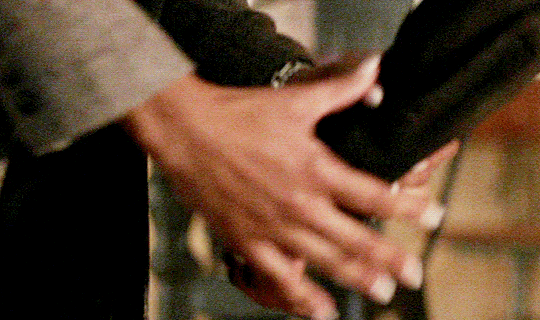
so there’s something i’ve been thinking about in terms of the portrayal of Ryan and Sophie’s relationship and how balanced/complete the development of their dynamic feels. in no way did it feel rushed or like it came out of nowhere, nor did it feel like it was shoved in our faces or stuffed down our throats. with some genius writing and savvy character arcs, Batwoman managed to find the perfect sweet spot in including Wildmoore into the show, and not just as an extra piece they tagged on to give Ryan a love interest (because in no way at all is Sophie Moore just a love interest), but their dynamic is literally EMBEDDED into the fabric of the story.

their whole relationship and its evolution is the driving force for the majority of the decisions they make, it’s the underlying conflict behind the visual action on screen, and most genius of all, while it’s shown from Ryan’s perspective, it’s mainly told from Sophie’s perspective.

Ryan’s the main character yet she’s almost a passive participant in her own romance. multiple times throughout this season i found myself thinking, what’s going on in Ryan’s head? but not Sophie. it was Sophie’s POV where we got the “I have feelings” conversation with her sister while she gazed lovingly at Ryan. it was Sophie who insisted on posing as Ryan’s girlfriend when meeting her mother. it was Sophie who said “great first date, huh?” at the end of said first date. practically every move to advance their relationship into romantic territory came from Sophie, and that’s because the Wildmoore plot line didn’t belong to Ryan—this plot line was mainly Sophie’s.
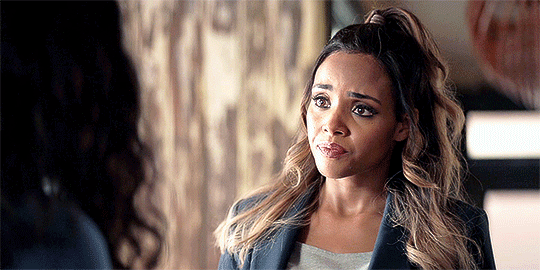
Sophie’s entire season 3 arc is the evolution of her relationship with Ryan/her struggle to gain Ryan’s trust and to be let in. despite this, Wildmoore never once felt one-sided and that’s thanks to Show Don’t Tell, a writing technique that the Batwoman writers used fabulously. let’s be real, Ryan has had a shit ton of conflicts to deal with this season. her story is already jam packed with CEO stuff, best friend issues, mama drama, a Joker brother, and psycho villains running rampant all over Gotham.
the last thing the writers needed was to try and squeeze in a conversation between Ryan and Luke about her feelings for Sophie, so instead of telling us, the writers used visual storytelling to show us the development of Ryan’s feelings; from inviting Sophie as her plus one to meet her mother, to openly flirting with Sophie, to being petty after Sophie slept with someone that wasn’t her, we got to subtly see the progression of Ryan’s interest in Sophie, while simultaneously hearing about Sophie’s frustration regarding it all.

the visual storytelling on Ryan’s side mixed with the verbal storytelling on Sophie’s side made for the perfect recipe in navigating and delivering a well-balanced romantic arc.
and to tie it all together, their character arcs finally meet!
Ryan’s resolution with her mother turns out to be the actual catalyst in resolving Sophie’s character arc.


they were connected all along, and let me tell you, the storytelling nerd in me is just gushing at this development. the resolution to a story should be unpredictable yet inevitable, and that’s exactly what happens here.
we always knew, to some extent, that Ryan and Sophie would be together, and we always knew that Ryan would find peace in her relationship with her mother, but in no way did i expect for those two storylines to connect, and to connect so brilliantly at that.

in her pursuit to gain Ryan’s trust, Sophie was front and center in supporting Ryan through meeting her mother and all the emotional turmoil that came with it, and as a result, Ryan got to learn about a (literal) missing part of herself which was just what she needed to let Sophie in.
man.
i sure love when things come full circle.
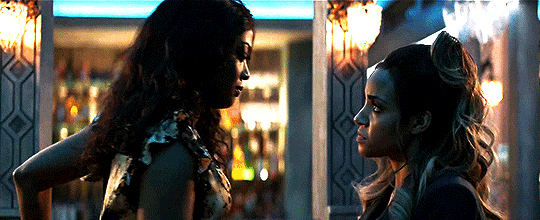
#we hate a hiatus but we love a hiatus because it gives me time to think about the brilliance of wildmoore#i just love them okay#wildmoore#batwoman#batwoman cw#ryan wilder#sophie moore#ryan x sophie#sophie x ryan#my analysis
434 notes
·
View notes
Text
Digimon shipping dynamic game
@atsoraasayoma
I am always a Takeru x hikari undying fan forever. Curious on your thoughts about them from another perspective. It’s probably been done to death in so many different ways but it’s refreshing any time just the same.
Send me two names among the following 12 and I’ll write a short analysis post about them:
Taichi Yagami | Yamato Ishida | Sora Takenouchi | Koushirou Izumi | Mimi Tachikawa | Jyou Kidou | Takeru Takaishi | Hikari Yagami | Daisuke Motomiya | Miyako Inoue | Iori Hida | Ken Ichijouji
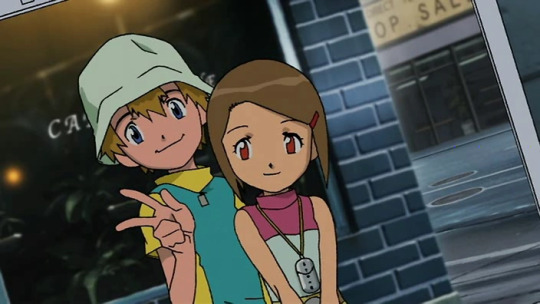
Whether canon provides input on them or not:
Takari are a very interesting case to look at in general, because, from an objective storytelling perspective, there are only few characters who are as consistently framed together in the way these two are (besides all the jogress combinations, namely Taichi/Yamato, Daisuke/Ken and, to a lesser degree, Miyako/Hikari and Takeru/Iori). This might take a little longer, since I actually haven’t paid too much attention to these two before, so bear with me:
Adventure 01 obviously doesn’t give them a lot of screentime together, as Hikari joins the group fairly late in the series and is also sick for a big chunk of it - however, they’re still played as parallels from the very beginning: Not only are they the youngest members of the Chosen Children and the siblings (and story-related foils) of the main fighters in the final arc, but they’re also the carriers of two of the most significant Crests, that are bound to bring the Light of Hope to everyone through their holy/angelic Digimon partners. These roles are even more strongly defined in the reboot and thus, they’re frequently seen next to each other - but it’s not the only thing they’re being paralleled for. Each of them has their very own set of brother complexes/issues, which are also important factors in how their relationship is developing and framed - from 01, 02, the movies, Tri to Kizuna. To put this rather shortly - Takeru, at first, projects onto Hikari in terms of wanting to protect her at all costs (just like Yamato overprotected him being the youngest and considered to be the “weakest”), whereas Hikari, at first, projects onto Takeru in terms of seeing him as someone she has to rely on (like Taichi).
02 frames them together, because they’re now the seniors of their new Chosen Children group, they share the memories, the experiences, the pain and the happy moments - they’re on good terms here, relaxed and visibly close to a point that makes Daisuke believe they’re actually a couple (who go on vacation trips together). But due to their issues, they do not really confide a lot in each other at this point. This is why Takeru gets angry at Hikari for being so dependant on Taichi (just like he was towards Yamato) and why Hikari deals with stuff on her own without asking for help up front (and will actually end up confiding more in Miyako as her jogress partner than Takeru). Their conflicts don’t really get resolved in 02, but one can see that there IS a foundation of trust between them, a connection, which is exactly why Takeru is able to track her down and reach her when she’s at the Dark Ocean, making them “connect through worlds” (which, in my opinion, is similar to how Taichi and Koushirou connected, even though this time, Takeru INTENTIONALLY wanted to connect with her to save her).
So it’s no surprise that they’re framed as rather close in Tri - which is logical, since the rest of their “usual” friend group has disappeared, so the youngest ones are left(overs) to stick together. Additionally, since they’re now 14, there is also a teasing element between them, with Hikari frequently nudging Takeru about his “ladies’ man persona” (and appearing a tiiiny bit jealous about it in the process), which Takeru downplays/deflects each and every time. Tri frames Hikari as noticing Takeru as a boy now, making her blush on a few occasions - whereas Takeru is framed to be her anchor, especially during the arc where Hikari thinks that Taichi has died, holding onto her, steadying her, giving physical comfort. So there actually is a bit of ship teasing here among the good old “him being protective of her vs. her being dependant on her brother” trope.
Last but not least, we have Kizuna, where they’re framed as being among the last remaining fighters to protect the real world from rampaging Digimon - trusting and relying on each other like, apparently, very comfortable partners in crime, who go on breakfast dates with their Digimon.
So the answer is yes - there is a LOT of material to work with, despite the fact that they were never confirmed as canon.
Whether I think why and how they’d work:
Based on everything I have outlined above, I believe that I don’t even have to mention why exactly this ship is probably one of the most popular Digimon ships world wide. Due to all the parallels between them (the Crests, the angels, the brothers), due to the fact that they’re consistently standing next to each other sharing (knowing) glances (because they’ve definitely seen things that bound them together), due to them seeming so comfortable by each other’s side (when things are not at stake), caring so much about each other’s wellbeing, it’s only logical to think of them as a romantic couple. It almost feels like they’re destined to be together - and I do think that it could definitely work, because them overcoming their respective traumas and start healing together could be the most wonderful thing (which, unfortunately, was never focused on in each of their arcs, because, most of the time, they’re really just foils for the sake of other characters’ developments). They’d have to tear down their respective walls for that though and that won’t be easy after all this time: Once Takeru opens up towards her about his doubts and fears, letting go of his fake smiles, masks and walls he built to make her (and everyone else) feel at ease, he could finally rely on her in return - that is, once he is able to see that he has projected onto her and that she’s more than capable to fight for herself. Once Hikari finally comes to terms with that she is indeed her own person for her own sake, not for Homeostasis, not for Taichi, or anybody else, once she can be honest towards Takeru and display her trust and affections in a genuine manner, they really could become the unstoppable “partners in crime” power couple - both on and off the battlefield. They already are mutually supportive and comfortable next to each other - with a lot of gentle teasing in between -, they just need to let loose a little more.
By the time they’ve reached their Kizuna ages, I could definitely see them spending study sessions together - with him comfortably practicing creative writing while she’s reciting her pedagogy teachings towards him. And since they’re both, apparently, very fond of coffee shops and the likes, one will frequently see them spending time there (also to provide Patamon with beverages of his choice and Tailmon with all the sweets she can get). Basically, I could see them spending a lot of their freetime together - and with their respective friend groups, just tagging along and having fun (for example gate hopping with the 02 gang or lounging around in Koushirou’s office with Taichi and Yamato).
Whether I’d prefer them as platonic or romantic ship:
This may sound a little bit weird regarding everything I have talked about so far, but despite the fact that I have grown to appreciate the romantic appeal of Takari a loooooot more throughout the last months, I always kinda preferred them as “platonic life partners”, if that makes sense? As outlined above, they have everything it needs to have a beautifully supportive, gentle and understanding relationship with each other that hits a lot of spots I usually fall for and I could definitely see them living together eventually - but rather as best friends (and also probably cuddle buddies, once they’ve gotten rid of their walls towards each other) than as classic romantic partners. I can definitely appreciate romantic framings for them, but I also love the idea of Hikari endlessly teasing Takeru about the ridiculous execution of his crushes (on Meiko for example), once he has finally admitted that his “dating phase” was just him trying to compensate. The boy has a lot of “broken family” related trauma, so him spending his life (whether romantically or platonically) with someone coming from a happy family to heal is still one of the best things (and the Yagami family has probably adopted him by now anyway, just like Koushirou). Takeru is the kind of person whose own romantic life needs a lot of time to actually get into motion, while he’s absolutely marvellous at sensing romantic opportunities for his friends (just like Mimi would, in my opinion) and that is why, in my opinion, he would be the best possible wingman for Hikari (to set her up with, for example, Koushirou or Miyako). They can both be absolute trolls when it comes to teasing their brothers (and others too) for example, so that’s absolutely something I could see them bonding over.
So yes, I’d actually enjoy both “timelines”, the one of them being platonic life partners as well as them being a romantic couple.
73 notes
·
View notes
Note
Please do go off about metanarratives and colaborative storytelling in LL if you want king, my analisys loving heart is curious and interested
Anon thank you so much I was really unsure to share this.
Warning for 3L and LL spoilers.
3rd Life and by extension, Last Life is a great example of a Metanarrative and an Emergent Narrative. The definition used of metanarrative for this is “An overarching account or interpretation of events and circumstances that provides a pattern or structure for people’s beliefs and gives meaning to their experiences”. An Emergent Narrative is “any video game storyline that is not written into the game by its developers, but emerges from the player’s interactions with various gameplay subsystems”.
Taking these definitions and placing it in the context of a collaborative Lets-Play series with multiple creators recording and taking part, allows us to analyze a complete storyline and find relevancy and meaning to the things the characters do/say/own, even if seemingly inconsequential from the start.
Multiple Perspectives and Metanarrative
The collaboration of 14 and 17 creators for each series is crucial in understanding how the story functions as it does. The individual’s viewing of a single point of view or POV of any single player reveals an amount of new information, interactions, and conflicts. The viewer’s knowledge of the single character’s experiences is about the same. When viewing multiple perspectives, the story expands significantly, showing different relationships between everyone and provides context to events that one may not have seen in the single POV.
For example, in viewing Impulse’s finale episode for 3rd Life, viewers may be confused or lost on why Bdubs attacked and took Impulse’s final life over a clock that Scar had given him. If the viewer had not seen Bdub’s first episode, they would not have realized the relevance between Bdubs and Scar with a clock, being that one was given to him at the very beginning from Scar during an early mining session. Viewers would also not know unless they had viewed Scar’s finale that the clock that was given to Bdubs was taken off of Impulse after losing his yellow life.
Immediately, the lack of viewership on multiple perspectives limits the scope on why the event is relevant, and the viewer may find the story ending dissatisfying, when in fact it is incredibly false. The cross-analysis of perspectives and events gives meaning to this otherwise simple event and forms a narrative from a simple item in the game- an Emergent Narrative.
Emergent Narratives, Lives, and Boogeymen
The term “subsystems” in the definition of Emergent Narratives is another way of describing a game’s mechanics. 3rd Life and Last Life differs from vanilla Minecraft in that they’re playing in a limited life, hardcore system, with the random threat of the Boogeyman and a proximity voice-mod. Without these, the narrative would be dramatically different, although it is possible to form an Emergent Narrative using vanilla Minecraft (DSMP!Eret’s Betrayal is a popular example). Because of these features and players interacting using these features, a narrative emerges from what in any casual Lets Play, could be considered a “bit”. This is what makes 3rd Life and Last Life stand out.
In 3rd Life, an emergent narrative is formed when Ren asks Martyn to kill him, despite Martyn being green and him being yellow. Ren’s use of the red life mechanic provided him a way to protect Renchanting under the threat and pressure of Scar. Ren (the player) judged being able to attack anyone at will overruled the safety of having multiple lives, and that he now poses as a new threat to the server. They also use a vanilla mechanic in renaming the Red Winter axe so all members could recognize their newfound power and creating a desirable item in their alliance. In “proving his loyalty”, Martyn and Ren’s storyline really kicks off and starts to conflict with the other members as a new power on the server.
A recent example in Last Life is from Scar’s perspective and goes to show just how possible it is that Last Life can/will follow a similar route as its counterpart. Bdubs in his first episode asks Etho, “if you were the Boogeyman and I died to a mob in here, would you be like, ‘man”, is that a consideration you’d make?”, “..like I missed my chance, should’ve taken them when I could. (Timestamp: Bdubs Last Life Episode 1, 17:20-17:38)
This is ironic, considering that Bdubs at the time was the Boogeyman. An episode later, one of the two boogeymen of the session, Joel leads Lizzie into a trap, getting in a few hits, only to fail and lose a life himself. The damage that he dealt to Lizzie weakened her was only after killed by a mob, and brings the scenario Bdubs suggested into reality.
Without the use of the limited lives, Boogeyman system, and the limited Enchanting table resource, this narrative thread would not have worked. And in the Metanarrative of the story, unless the viewers both viewed Bdub’s and Joel/Lizzie’s perspectives, they would not have found relevancy in this scenario.
Lack of Script
The most important part of the Metanarrative and Emergent Narrative is that no one knows that these events are important or are going to amount to something in the end. It is the viewer’s knowledge and creators’ forethought of the series to see the narrative emerge from just a couple of friends playing a video game and starting a war, to developed characters with an overarching storyline in a limited episode run. At the start, none of the stories was intentional. The individual’s interpretation of the events and forming these connections between one or more perspectives is the real storyline, and if the creator wants to support this discovered story, they can (Martyn and Scott’s 3L endings).
A great example of this inability to script events is in Bdubs’ 3rd Lift perspective. In his first episode, he passes by a cliff face with a pond below. As he approaches and looks down the cliff, he says, “Nobodies against each other, y’know, it’s just kinda hanging out.” As he passes by and down the hill, “Eventually, once we get down lower, like once you’re on your third life, I think then its vengeance time.” (Timestamp: Bdubs 3L Episode 1, 12:41- 12:51)
Because of his experiences and the events unfolding in 3rd Life, the irony is not lost when he is killed just at the bottom of the exact same cliff by Grian and Scar as revenge. These seemingly irrelevant events in the moment form patterns across the entire series, with some underdeveloped locations, suddenly becoming relevant. A seemingly irrelevant moment is now much darker and holds so much more meaning to the character.
What does this mean for Last Life’s story? Is there an Emerging Metanarrative?
Narratives can be found anywhere, and in collaboratively playing an open-world sandbox game, there’s almost no avoiding it. With the start of Last Life, any of these seemingly casual conversations or collected items could have any sort of meaning in the future. This happened in Scar’s episode this week where he worries that he’ll drop from 5 to 1 life and get boogeyman “Oh no- we’re gonna lose all of our lives, aren’t we? We have five lives and by the end of this I’m gonna be a red life.”(Timestamp: Scars LL Episode 2, 4:54-4:59)
Only in the end, for both him and Joel to be Boogeymen, and for Joel to drop to red and lose his alliance with Scar. The catastrophe of the episode essentially avoided Scar, even though he was constantly at the forefront of the conflict. These small off comments, seemingly inconsequential are now made relevant and active conflicts between the characters.
And there’s plenty more of these events across 3rd Life, and predicting what is to come is nearly impossible (though I do have my own ideas).
-Comments made towards Etho’s tree and wool base, only for both to be burned multiple times, and all of Etho’s deaths being related to fire.
-Martyn to BigB in early episodes, wanting to track down Ren and their relationship and building of Renchanting/Dogwarts
(Personal theory- there are currently 3 wither skulls on the last life server, belonging to Grian, Etho, and Pearl/Scott. Currently, they are irrelevant, but there are THREE WITHER SKULLS, with the entire server having easy access to soulsand.)
#3rd life smp#last life smp#last life smp spoilers#3rd life smp spoilers#emerging metanarratives is such an interesting concept to me
32 notes
·
View notes
Text
Character analysis: Vivienne de Fer (Dragon Age Inquisition)
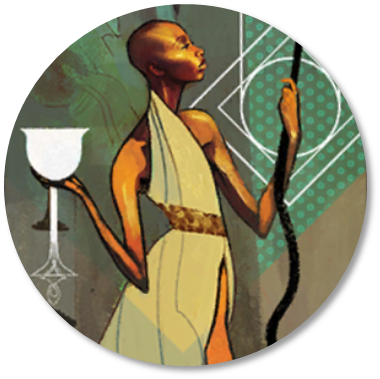
So, if you’ve wondered where I popped off to the past two months or so, I’m going to give you an answer - I finally bought Dragon Age Inquisition (legit on my gaming wishlist since its 2014 release) and I’ve been obsessed with it ever since.
The main draw to this game however, isn’t so much the gameplay (if you want a game that feels similar but has better gameplay - Assassin’s Creed Odyssey is what you’d want instead), but the storytelling and particularly the character development are top notch. All nine companions are fascinating and fleshed out in such a realistic manner I’m still gasping in awe on my fifth playthrough.
Thus, a post on it is in order. It’s a bit different from my usual content, but don’t let that discourage you - clearing my head from Dragon Age will allow me to let Eurovision back in and continue my unfinished 2020 ranking.
In this post, I will be analyzing one of DAI’s most interesting characters - none other than Madame de Fer herself, Vivienne.
Now, I’m under the impression that this is a rather unpopular opinion but I absolutely love Vivienne. And no, I won’t apologize for it. As a Templar-thumping elitist with a icy, sardonic demeanor the sheer ‘Idea Of A Vivienne’ is meant to make your head spin. Dragon Age has always been a franchise in which mages are a socially surpressed group and to be confronted with a socially confident enchantress who likes Templars and seemingly supports the social shunning out of her own ambition is the walking embodiment of flippancy.
and yet, I feel a lot of sympathy for Vivienne.
Yes, she’s a bitch. She knows she’s one and she’s a-ok with it. I won’t argue with that. Sadly, the “Vivienne is a bitch” rhetoric also drastically sells her short. Vivienne is highly complex and her real personality is as tragic as it is twisted.
Madame de Fer
So let’s start with what we are shown on the surface. Vivienne is a high-ranking courtier from an empire notable for its deadly, acid-laced political game. She seemingly joins the Inquisition for personal gain, to acrue reputation and power, and eventually be elected Divine (= female pope) at the end of the game. She presents herself as a despicable blend of Real Housewife, Disney Villain, and Tory Politician, all rolled into one ball of sickening, unctuous smarm. Worse, the Inquisitor has no way to rebuke Vivienne’s absurd policies and ideas. You can’t argue with her, convince her to listen to your differing viewpoints or even kick her out the Inquisition. She has a way with words where she can twist arguments around in such a fashion that she lands on top and makes the other person look like the irrational party.
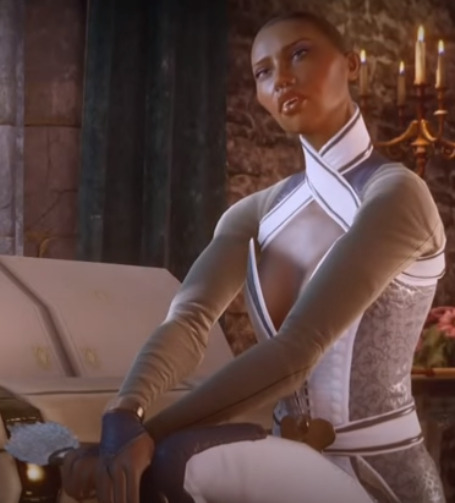
“Thus speaks the Inquisitor who has made so many mature and level-headed choices so far. Such as releasion malcontents upon the population without safeguards to protect them should they turn into abominations. Very wise. I rearranged some furniture. Lives aren’t thrown into jeopardy by my actions. Perhaps a little perspective is needed.”
She’s Cersei Lannister on creatine, Dolores Umbridge on motherfucking roids. If you look at merely the surface, then yes, Vivienne looks like the worst person ever created. I love a good anti-villainess however, and she’s definitely one.
Yet, she never actually does anything ‘evil’? Yes, she is ‘a tyrant’ as a Divine, but 1) the person saying this is Cassandra, whose dislike for mage freedom is only matched by her dislike of being sidelined 2) Divine Vivienne isn’t bad to mages either? (hold that thought, I’ll get to it). She never actually sabotages the Inquisition, no matter how low her approval with the Inquisitor gets. She never attempts to stop them, no matter how annoyed she is. She’s one of the most brutally honest companions in the cast, in fact. (It always surprises me people call her a ‘hypocrite’ - you keep using that word and it doesn’t mean what you think it means.) The ‘worst’ display of character is when she attempts to break up Sera and the Inquisitor and even then - are we going to pretend Sera isn’t a toxic, controlling girlfriend with a huge chip on her shoulder? I love Sera, but come on.
Vivienne is a character where the storytelling rule of Show, Don’t Tell is of vital importance. The Orlesian empire is an empire built around posturing and reputation. Nobody really shows their true motivations or character, and instead builds a public façade. It’s like how the Hanar (the Jellyfish people) in Mass Effect have a Public name they use in day-to-day life, and a Personal Name for their loved-ones and inner circle. Vivienne’s ‘Public Visage’ is that of Madame de Fer - this is the Vivienne who openly relishes in power, publicly humiliates grasping anklebiters with passive-aggressive retorts, the woman who is feared and loathed by all of Orlais, and this is the Face you see for most of the game.
The real beauty of Vivienne’s character and the reason why I love her as much as I do (which is to say - a LOT) are the few moments when - what’s the phrase DigitalSpy love so much - Her Mask Slips, and you get a glimpse of the real woman underneath the hennin.
This is the Vivienne who stands by you during the Siege of Haven and approves of you when you save the villagers from Corypheus’s horde.
This is the Vivienne who comforts you when you lament the losses you suffered.
This is the Vivienne who admires you for setting an example as a mage for the rest of Thedas.
This is the Vivienne who worries about Cole’s well-being during his personal quest, momentarily forgetting who or what he is.
This is the Vivienne who, when her approval for the Inquisitor reaches rock bottom, desperately reminds him of the suffering mages go through on a day-to-day basis because of the fear and hatred non-mages are bred to feel towards them and how this can spiral into more bloodshed without safeguards.
This is the Vivienne who shows how deep her affection for Bastien de Ghislain truly is, by bringing you along during his dying moments. I love this scene btw. This is the only moment in the entire game where Vivienne is actually herself in the presence of the Inquisitor - needless to say, I consider anyone who deliberately spikes her potion a motherfucking psychopath ^_^)

“There is nothing here now” fuck I *almost* cried at Vivienne, get out of my head BioWare, this is WRONG -- people who delude themselves this is an irredeemable character.
So, who is Vivienne really?
Understanding Vivienne requires recognizing that the mask and the real woman aren’t the same person. I think her relationship with Dorian is the prime example of this. I love the Vivienne/Dorian banter train, obviously - an unstoppable force of sass colliding with an unmovable wall of smarm is nothing short of a spectacle. However, there’s more to it than their highly entertaining snipes. As the incredibly gifted son of a magister, Dorian represents everything Vivienne should despise, and should be a natural enemy to her. And yet, she doesn’t and he isn’t.. Their gilded japes at each other are nothing more than verbal sparring, not dissimilar to how Krem and Iron Bull call each other names when they beat each other with sticks. In what I think is one of the most brilliantly written interactions between characters in DAI, I present Vivienne’s reaction when the Inquisitor enters a romance with Dorian:
Vivienne: I received a letter the other day, Dorian.
Dorian: Truly? It's nice to know you have friends. 🙄
Vivienne: It was from an acquaintance in Tevinter expressing his shock at the disturbing rumors about your... relationship with the Inquisitor.
Dorian: Rumors you were only too happy to verify, I assume. 🙃
Vivienne: I informed him the only disturbing thing in evidence was his penmanship. 🙂
Dorian: ...Oh. Thank you. 😳
Vivienne: I am not so quick to judge, darling. See that you give me no reason to feel otherwise.
Madame de Fer can never be seen directly expressing approval to a relationship between the Herald of Andraste and an ‘Evil’ Tevinter ’Magister’. By this subtle, subtle conversation, Vivienne indirectly tells Dorian that she considers him a good match for the Inquisitor and approves of the romance. It’s one of those reasons why I could never truly dislike Vivienne - between the layers of elegant poison lies a somewhat decent woman who never loses sight of the bigger picture. Not a good person maybe, but not one without some redeeming qualities.
The crux of Vivienne’s personality is that she, like all DAI companions, is a social outcast. She’s a mage in a fantasy setting where mages are psionically linked to demons, and grew up in a country where the majority religion has openly advocated the shunning and leashing of mages (’Magic exists to serve man’ - the Chantry is so, so vile in this game.). Vivienne’s “gift” was discovered so early in her life that she can barely remember her parents. Vivienne grew up in a squalid boarding school, learning from a young age that she’s dangerous and her talents need to be tamed and curbed. She is also terrified of demons, as her banters with Cole point out:
Cole: You're afraid. You don't have to be.
Vivienne: My dear Inquisitor, please restrain your pet demon. I do not want it addressing me.
Inquisitor: He's not doing any harm, Vivienne.
Vivienne: It's a demon, darling. All it can do is harm.
Cole: Everything bright, roar of anger as the demon rears. No, I will not fall. No one will control me ever again.
Cole: Flash of white as the world comes back. Shaking, hollow, Harrowed, but smiling at templars to show them I'm me.
Cole: I am not like that. I can protect you. If Templars come for you, I will kill them.
Vivienne: Delightful. 😑
Vivienne’s Harrowing is implied to have been such a traumatizing event to her that she’s developed a pavlovian fear of demons ever since. (Hence her hostility towards Cole.). Vivienne is fully aware of the inherent dangers of magic, and projects this onto all other mages.
Besides, given how Dragon Age has a history with mages doing all sorts of fucked up shit, ranging from blood magic, murder, demonic possession and actual terrorism (yes, *ElthinaBITCH* had it coming, but let’s not pretend like Anders/Justice was anything other than a terrorist), Vivienne’s policies of controlled monitoring and vigilance are actually significantly more sensible than the options of ‘unconditionally freeing every mage all over Thedas’ and ‘reverting back to the status quo before the rebellion’. They’re flawed policies, obviously. When Vivienne says “mages” she pictures faceless silhouettes foremost and not herself. Regardless, unlike Cassandra and Leliana, Vivienne is aware of the fear others harbour for her kind, and how hard it is to overcome such perceptions.
Additionally, Vivienne’s a foreigner. She is an ethnic Rivaini, a culture associated with smugglers and pirates (Isabela from DAO and DA2 is half-Rivaini). This adds an additional social stigma, again pointed out by Cole:
Cole: Stepping into the parlor, hem of my gown snagged, no, adjust before I go in, must look perfect.
Vivienne: My dear, your pet is speaking again. Do silence it.
Cole: Voices inside. Marquis Alphonse.
Cole: "I do hope Duke Bastien puts out the lights before he touches her. But then, she must disappear in the dark."
Cole: Gown tight between my fingers, cold all over. Unacceptable. Wheels turn, strings pull.
Cole: He hurt you. You left a letter, let out a lie so he would do something foolish against the Inquisition. A trap.
Vivienne: Inquisitor, as your demon lacks manners, perhaps you could get Solas to train it.
This is the only palpable example of the casual racism Vivienne has to endure on a daily basis - Marquis Alphonse is a stupid, bigoted pillowhead who sucks at The Game, but remember - Vivienne only kills him if the Inquisitor decides to be a butthurt thug. She is aware that for every Alphonse, there are dozens of greasy sycophants who think exactly like he does, and will keep it under wraps just to remain in her good graces.
Finally, there’s the social position Vivienne manufactured for herself, which is the weak point towards her character imo. Remember, this woman is a commoner by birth. She doesn’t even have a surname. Through apparently sheer dumb luck (or satanic intervention) she basically fell into the position of Personal Mage to the Duke of Ghislain. Regardless, ‘Personal mages’ were the rage in Orlesian nobility, and the prestigious families owned by them like one may own a pet or personal property. By somehow becoming Bastien de Ghislain’s mistress and using his influence, "Madame de Fer” liberated herself from all the social stigmata which should have pinned her down into a lowly courtier rank and turned the largely ceremonial office of “Court Enchanter” into a position of respect and power. This is huge move towards mage emancipation by the way, in a society where, again, Mages are feared and shunned and are constantly bullied, emasculated and taught to hate their talents. Vivienne is a shining example of what mages can become at the height of their power. Power she has, mind you, never actually abused before her Divine election. Vivienne’s actions will forever be under scrutiny not because of who she is, but because of what she is. The Grand Game can spit her out at any moment, which will likely result in her death.
Inquisitor: “You seem to be enjoying yourself, Vivienne?”
Vivienne: “It’s The Game, darling. If I didn’t enjoy it, I’d be dead by now.”
Whether Vivienne was using Bastien for her own gain or whether she truly loved him isn’t a case of or/or. It’s a case of and/and. The perception that she was using Bastien makes Vivienne more fearsome and improves her position in the Grand Game, but deep down, I have no doubts truly loved him. Remember, Vivienne’s position at the Orlesian court was secure. She had nothing to gain by saving Bastien’s life, but she attempted to anyway. That Bastien’s sister is a High Cleric doesn’t matter - Vivienne can be elected Divine regardless of her personal quest’s resolution. She loved him, period.
No, I don’t think Vivienne is a good person. She treats those she deems beneath her poorly, like Sera, Solas, Cole and Blackwall (characters I like less than Vivienne), which I think is the #1 indicator for a Bad Personality. But I don’t think she qualifies as ‘Evil’ either and I refuse to dismiss the beautiful layering of her character. I genuinely believe Vivienne joined the Inquisition not just for her personal gain, but also out of idealism, similar to Dorian (again, Cole is 100% correct in pointing out the similarities between Dorian’s and Vivienne’s motivations for joining, as discomforting it is to her).
In her mind, Vivienne sees herself as the only person who can emancipate the mages without bloodshed - her personal accomplishments at the Orlesian court speak for themselves. Vivienne isn’t opposed to mage freedom - she worries for the consequences of radical change, as she believes Orlesian society unprepared for the consequences. Hence why she’s perfectly fine with a Divine Cassandra. Hence why her fellow mages immediately elect her Grand Enchanter of the new Circle.
Hence why Vivienne is so terrified by the Inquisitor’s actions if her disapproval gets too low. The Inquisitor has the power to completely destroy everything she has built and fought for during her lifetime. Remember: Vivienne’s biggest fear is irrelevance - there’s no greater irrelevance than having your life achievements reverse-engineered by the accidental stumbling of some upstart nobody. This is the real reason why she joins, risks her life and gets her hands dirty - the only person whose competence Vivienne trusts, is Vivienne’s own.
Even as Divine Victoria, I’d say she’s not bad, at all actually. Vivienne has the trappings of an an Enlightened Despot, maintaining full control, while simultaneously granting mages more responsibility and freedom, slowly laying the foundations to make mages more accepted and less persecuted in southern Thedas. Given that Ferelden is a feudal fiefdom and Orlais is an absolute monarchy, this is a fucking improvement are you kidding me. (Wait did he just imply Vivienne is secretly the best Divine - hmm, probably not because Cass/Leliana have better epilogues - but realistically speaking, yes, Viv should be the best Divine and it’s bullshit that the story disagrees.)
Underneath the countless layers of smarm, frost and seeming callousness, lies a fiercely intelligent and brave woman, whose ideals have been twisted into perversion by the cruel, ungrateful world around her. Envy her for her ability to control her destiny, but know that envy is what it is.
The flaw in Vivienne’s character isn’t so much the ‘tyranny’ or the ‘bitchiness’ or the 'smarm’. Her flaw is her false belief that she is what the mages need the most. Her belief that her competence gives her the prerogative to serve the unwashed mage masses... by ruling over them. For all intents and purposes, Vivienne is an Orlesian Magister and this will forever be the brilliant tragedy of her character. She was created by a corrupt institution that should, by all accounts fear and loathe her but instead embraced her. It’s that delirious irony that makes Vivienne de Fer one of the best fictional characters in RPG history.
the next post will be Eurovision-related. :-)
#RPG#Dragon Age#Dragon Age Inquisition#Vivienne#Vivienne de Fer#Madame de Fer#DAI#Dragon Age 3#BioWare
180 notes
·
View notes
Text
American Psycho (2000) Review - Important Conversations, Handled Clumsily
An ambitious indictment of greed, capitalism, and masculinity that beckons respect but doesn’t land every mark. ★★★☆☆ - above average, leaning towards good
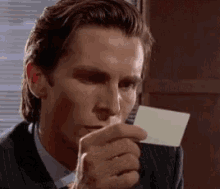
If time is a flat circle, then it stands to reason that history is similarly shaped. I’m sure you’ve heard the adage, “Those who cannot remember the past are condemned to repeat it.” American Psycho’s most impressive (and terrifying) features come from the fact that it still feels so…contemporary, in spite of it being a 22-year-old movie, depicting an era that proceeded it by 20 years.
This movie was very similar in structure to The Fallout, a 2021 movie that is probably in the top 5 films of that year, though it might be more accurate to say that The Fallout is similarly structured to this film (what did I say about time being a flat circle?). Instead of a traditional plot-oriented structure, the film opts for a character-centered approach, focusing on the titular American Psycho, Patrick Bateman. This lends itself to each scene having a much larger interested in affective storytelling than narrative. Each scene builds on the spiral that Bateman takes into madness. We question his sanity, both in the normative sense, and his ability to accurately narrate the world around him. The world is seen through his distorted lens, and that is the movie’s biggest strength. Everything, from his vapid sensibilities, to the material realities of his caste, reflect this warped worldview that see money, status, power, and bravado as the most important areas of life. Everyone in the film is one-dimensional, because that’s how they see remaining in the seats of power that they currently occupy.
One of the biggest dangers of not having a traditional movie narrative structure is that you risk scenes blending together, or generally having a feeling of stagnation during sections of the movie. This is where the movie falls apart for me. For swathes of the movie, I felt like I saw through the routine, and at that point, I wondered what showing similar actions over and over again added to my experience. There wasn’t really anything satisfying about the violence; I just felt bad for everyone. This feeling of…pointlessness is exacerbated by a [twist in the third act] that caused me to wonder even more broadly about the purpose of that twist and how it was meant to serve the narrative in a satisfying way. I can see why they did it, but I feel like there was a way to have that resonance and achieve a satisfying character moment for Bateman.
Overall, I think that this movie has a lot going for it, and it really reaches for the stars in a lot of ways. I commend it for that. I just feel that the experience is too contrived and uneven for it to be something that is recognized as a mainstay of the cinematic landscape, from a meritocratic perspective.
Final Verdict: If you like slashy-killy movies that are a little more cerebral than the usual fare of the genre, this movie will probably win you over. It's not as cringe as you would think it is from the way incels latch onto it. Just don't go expecting an academic analysis of the beginnings of what can be seen as modern American society.
#christian bale#patrick bateman#films#film#cinema#film reviews#film review#2000s movies#american psycho
2 notes
·
View notes
Text
a word on color - how line of duty series 6 uses wardrobe color to frame narrative (pt 4)
Author’s note: this is the conclusion to my essay on wardrobe color and how it’s used to inform narrative in series 6 of line of duty. Previous parts can be found here: Part 1, Part 2, and Part 3. This part covers episodes 5, 6, and 7. Heads up, my analysis of episode 7 is actually quite short because of my focus on Jo, but I have many, MANY thoughts on Kate’s second to last scene and the general wardrobe choices for Kate in this episode.
Thank you to everyone who has been willing to entertain my ramblings here. While I have a background in theatrical production, this kind of meta analysis was quite new for me. I was relieved to see (most) of this theory actualized in the finale. Now, this part is nearly 8k words, all four parts together clocked in at over 20k words and nearly 40 pages, single-spaced, so I’ve officially written a third dissertation (after the other two took me 10 months…).
Regular warnings apply: I’m American and therefore may be missing certain cultural context. Spoilers abound, but I stick to Jo’s storyline for the most part, and don’t include my thoughts about the finale writ large (I may write an analysis of the series 6 storytelling separate from this, if there’s interest).
Read on below the cut.
EPISODE 5
Episode 5 opens with Lomax briefing Jo and Kate about connections between the armed robbery and Gail Vella's murder, showing them results for an industrial estate that matches the description given by one of the robbers. Jo is wearing the same outfit she ended episode 4 in, the orangish brown sweater and navy suit, while Kate is wearing a grey jacket over a white shirt, buttoned all the way up. A side note - this grey jacket does not fit in with the rest of the wardrobe Kate has been in all series, and from a meta perspective, this is because they have to conceal the firearm Kate is now carrying. Ryan watches from the other room, again in a call back to the way Jo was watching Kate in episode 3. Kate tries to talk to Jo, but she's quickly brushed off, much to Kate's chagrin.

Jo’s outfit, which we’ve seen her in numerous times, again demonstrates her pull between what’s right and pressure from the OCG. After all, Ryan has just threatened her twice. She knows that the investigation is heading in the right direction, which she both wants and is afraid of, and she is panicking. At the same time, she’s wary of letting Kate get too close lest she suspect something and acts on it, putting them both in danger.
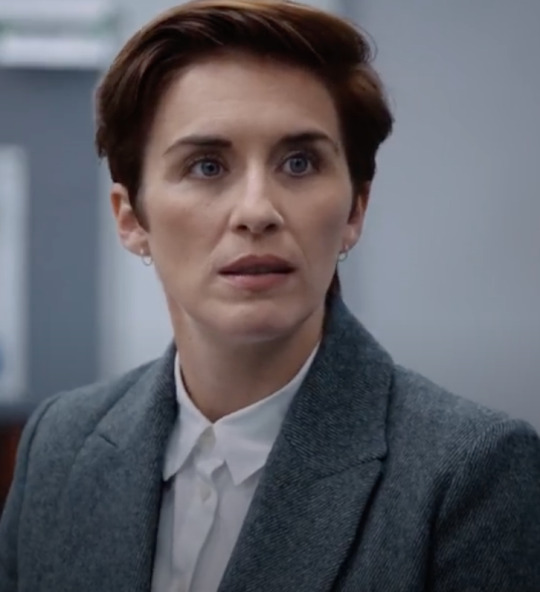
Kate’s outfit actually shows some of that forced distance Jo is causing. We’ve seen her wear a white shirt buttoned all the way to the top once before - when she spoiled the raid of MIT by AC-12. That outfit showed her pull between Jo and AC-12, and we’re seeing that here again. This time though, the grey jacket shows that she’s leaning AC-12.
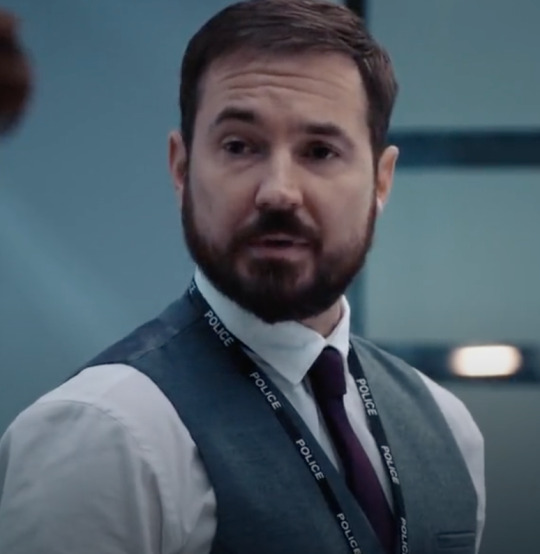
We see this in the next scene where Steve, in his grey suit with a white shirt and red tie, is directly paralleling his former partner’s wardrobe. Kate visits AC-12, and it's been revealed that she has permission to carry a concealed firearm because of the threat Ryan Pilkington poses. Now, call me crazy, but I believe we’re meant to understand he’s a threat to her at least in part because of her relationship to Jo, but I’m uncertain. When Ted asks for an update, Kate notes that Jo has become "cold and distant" toward her, and the team reveals Jo has been put under surveillance, which Kate isn't happy about. It's then revealed that Jo is related to Tommy Hunter (from series 1 and 2) through incest, which is of course horrifying, though we don’t know the full story of it quite yet.
Back at her apartment, Jo checks the laptop to find out the OCG won't let her go because of AC-12's continued investigation, which she promises to take care of. She’s surrounded by her blue flat, in her navy and orange outfit, her actions and heart still at conflict with one another. She’s distraught, and stuck.
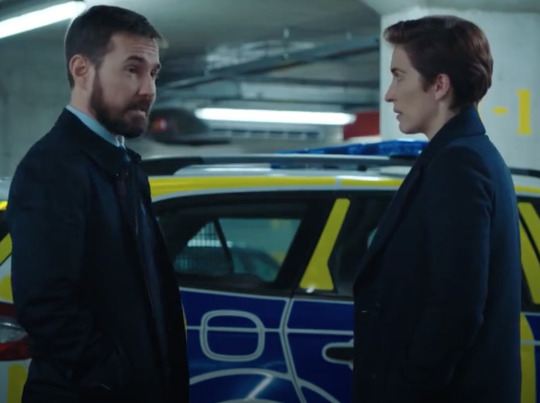
Later, Kate and Steve meet in an underground car park in their matching navy coats. Steve shares that Lakewell gave him information off the record, which is that Gail Vella had been looking into the death of Lawrence Christopher at the time of her death. He also tells Kate about his discovery that Hastings gave Steph Corbett the missing $50k of supposed bribe money (from series 5). The former partners match here because they are coming closer to being full partners again, working in tandem and trusting one another with information. They have been at odds this series, particularly when it comes to Jo, but they have remained on the same page in their disappointment in the gaffer and belief in finding justice for Gail Vella.

Back at MIT, Kate is looking into the industrial parks that may hold an OCG workshop. As she researches, she repeatedly looks over at Jo in her office and seems to have an idea. She then steps out of the office and calls Steve, though we don’t see the details of their conversation. Kate returns to the office and goes into Jo's office, telling her that they may have found the OCG workshop. She asks to brief the team immediately to avoid leaks, which Jo allows while glancing out at the bullpen. We can see once Kate leaves that she was looking at Ryan, who is watching her closely.
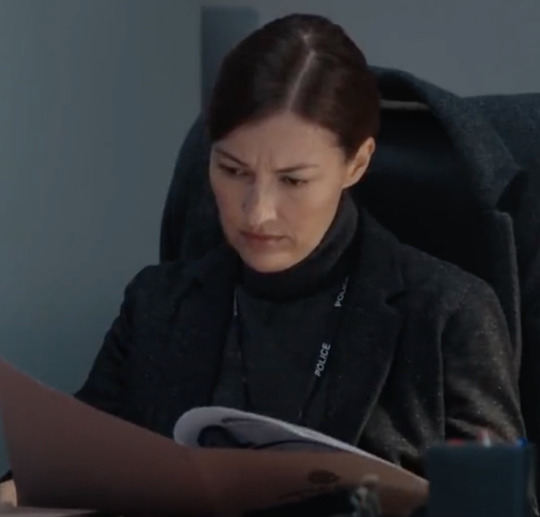
We don't know it yet, but Kate has found a way to test Jo’s loyalty and her belief that Jo isn’t bent. She tells the team about 1 location, makes them hand up their phones (which pisses them all off), and Jo makes them all stay within the MIT offices just as Ryan is about to step out. As the briefing ends, Kate goes to Jo’s office once more and demands to speak with her, despite Jo’s rude and annoyed response.
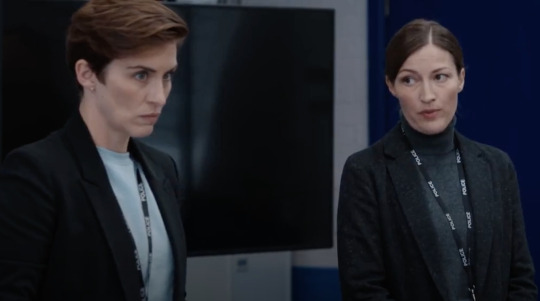
It’s later revealed that Kate then tells Jo there are 3 total locations to be looked at, but they’re starting with just one. Meanwhile, AC-12 surveillance teams are stationed at all three locations to see if people are tipped off and by who.
In these scenes, Kate is wearing a navy suit with a light blue shirt buttoned to the top, while Jo is wearing a grey suit with a grey turtleneck. For both women, the high necklines that fully encircle their throats indicates their discomfort and their desire to have a wall up for their own protection. We see Kate in all blue as she’s on a crusade to prove the truth - Jo isn’t bent, and this will reveal who is (as she suspects Ryan). Jo, meanwhile, is uncertain, and her monochrome grey outfit reflects that. Normally, this is the type of thing she would be expected to tip off to the OCG (as she did with Carl Banks), but Kate has cleverly made it so she can’t. She’s trying to push Kate away, but Kate keeps pushing herself right back in. She’s meant to be wary of Ryan, but she stopped him from an opportunity to send out a warning - and that’s before she knew there were three potential locations. All Jo knows is that she wants out from this lie and constant threat she’s lived under. She’s in all grey, not true blue but certainly not a warm tone, because she hasn’t decided what her next step is yet. Temporarily neutral.

The initial raid is not a success, so Jo informs the team that they'll move on to the other locations instead, revealing that she and Kate did not give them all of the information. Lomax is pissed off, and directs that anger at Kate. From his perspective, the boss just told them she doesn’t trust him or the team and treated them all like a potential rat, and he chalks that up to the former AC-12 officer’s involvement. In an interesting parallel, Jo and Kate are wearing the same outfits under their body armor that we saw them in during the raid in the first episode - Jo in her black jacket and Kate in her green jacket.
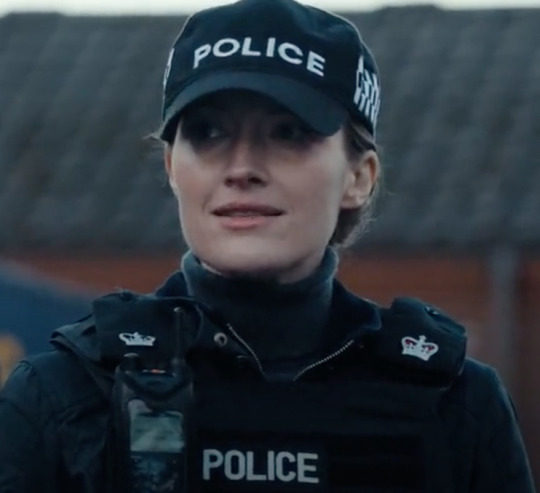
During this raid, Ryan snuck out to call in the danger to the OCG from a burner phone, an act which was recorded by Chloe “the only real detective” Bishop. Steve, at the real OCG workshop, rushes in with his team which results in the deaths of two suspects. Jo and the MIT team arrive on the scene not long after, and Jo and Steve come to disagreement over jurisdiction, and she ultimately forces him to stand down using her rank (which we’ll see her flex once more later in the episode). I have to say, I have loved watching Jo and Steve come to blows in this series in part because Jo is so much better at it than he is. Steve truly has been Jo’s foil, contradicting her at every point. We see this even in their clothes in this scene. While Jo is wearing a grey turtleneck (typically in the AC-12 color palette), it is hidden under her black jacket, and Steve is wearing a blue shirt under his body armor. On the visual face, they appear to be working at opposite ends to one another, and in this moment they are.
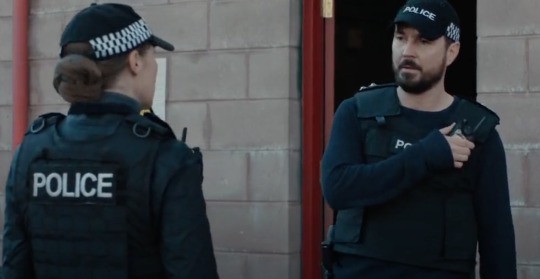
Back at AC-12, Kate debriefs the team on what happened and let's them in on the honey trap* (*not really) Kate set for Jo, which she didn't fall for (but Pilkington did). The team is taken aback, and Hastings points out how risky a move that was. "As far as I'm concerned, that's proof she's not bent," Kate replies, stubborn to the end. Steve has a different interpretation - Jo assigned herself to the raid on the location with the workshop, and took control of the crime scene from him. "That doesn't fit with what I've witnessed firsthand. I needed to know one way or another." Kate will not back down from her staunch belief that Jo is not bent, an unfortunate foreshadow to Jo’s eventual betrayal. Hastings sides with Steve, but Kate clearly still disagrees. However, Steve does believe Ryan should be removed from MIT, even as Hastings wants to keep him there. This raises their suspicions because Kate had originally talked the gaffer out of bringing Ryan in, but the reality of the matter is that Ted feels he’s on a ticking clock with his forced retirement, and wants to handle this fourth man situation before he goes.
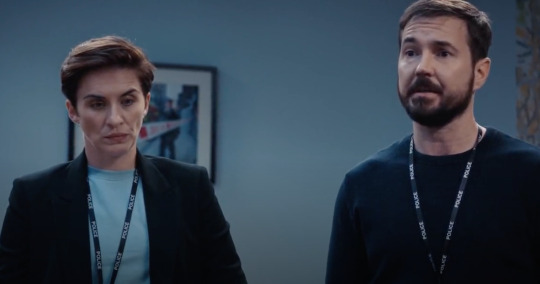
Kate and Steve are again in coordinated outfits here, dressed head to toe in blue. We’ve seen this before, the former partners in clothes that parallel one another while seemingly at odds. Sadly, this is because they’re again both right about Jo. She is using her position (and even Kate’s trust) to manipulate the investigation, but that manipulation stems from fear for her own safety as she herself is being manipulated and doesn’t want to do what she’s done. She’s like a cat stuck in a box - bent and not bent.
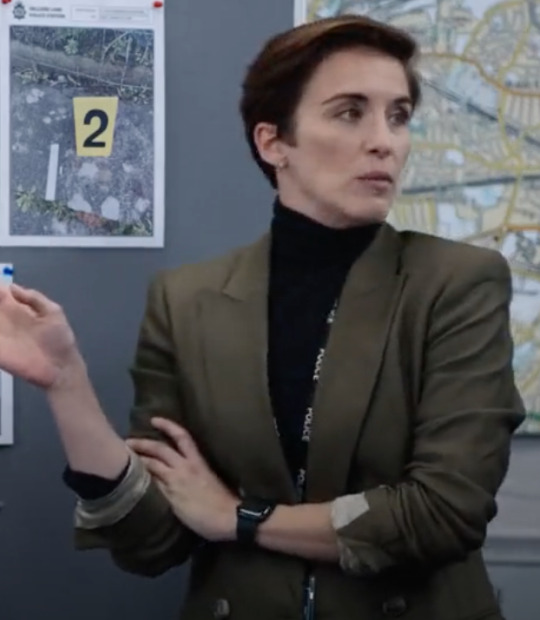
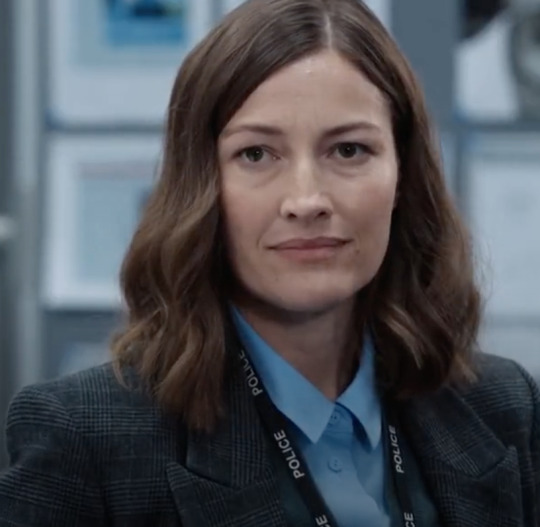
On the Hill, Kate gives the team the low down on the OCG warehouse and their next steps. Jo congratulates the team and tells them to get to work collecting forensic evidence while Pilkington sends laser eyes her way. This time it’s Kate wearing a turtleneck, this one in black under an olive suit jacket, while Jo wears a grey suit with a grey-green sweater and a blue shirt buttoned all the way to the top. Again, the high necks of these outfits demonstrate the discomfort and reservedness both women are feeling, but we also see a subtle connection with the green tints of their clothes. As usual, green represents the pull between two different compelling interests. For Kate, the pull between Jo and AC-12, for Jo the pull between Kate and the OCG.
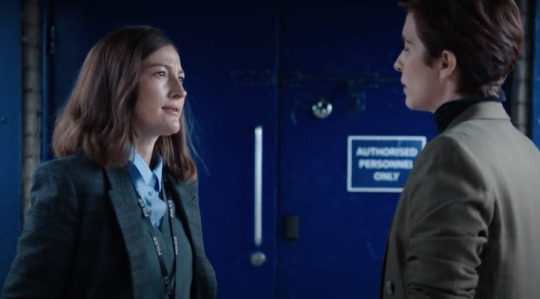
Wearing these same outfits, Jo catches up with Kate outside of Hillside, where she confronts her about AC-12's knowledge of the raids. Kate tells her she tipped them off because they're making a lawful inquiry. "Look, I'm telling you the truth Jo, because I trust you with it." Jo takes advantage of Kate sharing the information with AC-12 and tells Kate to put in a transfer request, saying, "I wouldn't want to harm your career, Kate. It's best if you request a transfer." Kate is taken aback and asks "You've been distant with me for days. Is this personal?" Jo denies this, pulling rank the same way she did with Steve, "I'm your senior officer, I should be distant." Kate seems confused and concerned with her response of "But I thought we were friends. What's happening here?" And here we see Jo’s fear crack through her irritation, just for a moment, when she says, "So you can tell AC-12?" As much as Jo is pushing Kate away in order to get her out of the picture, she also has a real fear that Kate continuing to share information with Steve will get Jo killed. She’s playing up Kate’s betrayal to explain her anger, but she’s also hurt and she wants her to know that. Jo trusts Kate, even if she doesn’t trust her enough to tell her the truth on her own. Up until this point, Kate has worked with her and told her about AC-12’s work, even helping her get a leg up on Steve. Now Kate’s helping AC-12 get a leg up on her.
But Kate is nothing if not determined. "No, I wouldn't tell them personal stuff." Kate refuses to take the transfer, and Jo leaves in frustration and anxiety, leaving Kate confused yet again.

Back at Jo's flat, she's on the OCG laptop again. She tells the user she can handle AC-12, but they claim she can't because of Fleming. Jo tries to ask for more time to sort it, but time's up. "Get rid of her." Get rid of Kate, the last person Jo trusts, the one who just broke her trust.
And here is Jo’s betrayal. "As long as it's my last job." She looks devastated after she sends it, and she is. What she’s about to do is unforgivable. But scared and vulnerable people often do unforgivable things to save themselves. Jo just wants to be free, and she’s willing to pay a price for freedom.

Steve, in his iconic grey suit and navy tie, goes to visit Ian Banks in prison and learns that Ted is the one that disclosed John Corbett's identity that later got him killed. He later calls Kate to tell her the news. Matching Steve, Kate is in a navy shirt, but is wearing a black suit, only the second time we’ve seen her in this suit. The first was in episode 2, when she gave Jo the information about AC-12 and they later had dinner together.
Kate heads back into Hillside after her conversation with Steve and runs into Jo in the hallway, who asks to meet with her outside of work to discuss their 'personal issues'. Jo specifically looks at officers further down the hall to confirm they're leaving before speaking to Kate. She also lowers her voice at her own mention of personal issues, adding an extra layer of privacy to an already empty hall.
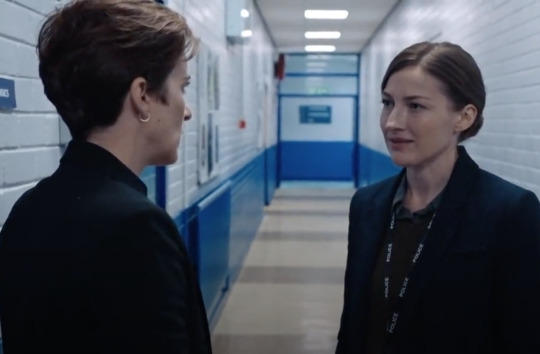
Checking to make sure there alone is something that Jo and Kate have done frequently throughout this series. In the handhold scene, they break apart when officers step into the hall. They mention how it’s easier to talk outside of work during both of their dinner scenes. When Kate tells Jo about Ryan’s spying, she dismisses Chris first, and later in that conversation when Jo puts her hand on Kate’s arm, they pull apart when they hear officers approaching.
Kate is surprised at Jo’s sudden change in behaviour from the past few days, but she agrees to meet with Jo after work. As Jo walks away, Kate clearly knows that something is up with her, but seems willing to find out what it is when they speak.
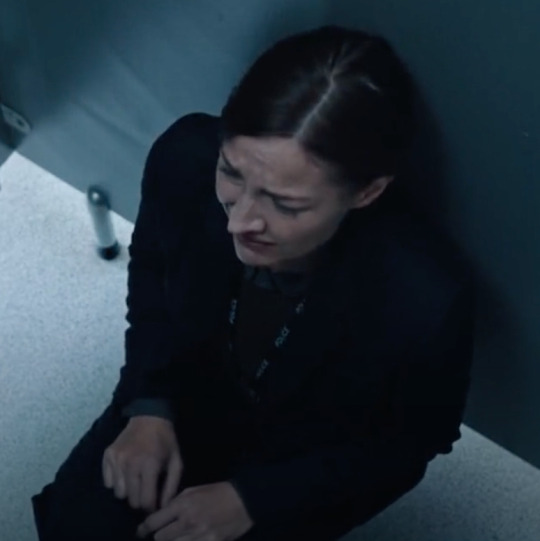
What Kate is sadly unaware of is that Jo walks away to lock herself in the bathroom and have a breakdown, distraught at the machination she has set in motion against Kate. Her hand shakes as she locks the stall, she falls to the ground, she looks around desperately for salvation. Jo’s mask, one that she maintains so strictly, falls for just a moment (not dissimilar to her breakdown in her car after framing Farida). Thirty seconds in a toilet stall to breakdown, to think about the consequences of her actions, about what she’s done to Kate. But she takes a few deep breaths, wipes away her tears, and we watch as her mask slips back into place.
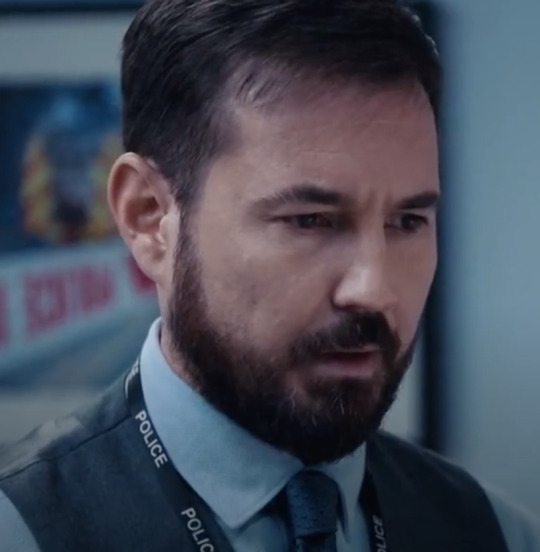
Back at AC-12, Chloe “my back is worse than Steve’s from carrying this investigation” Bishop has uncovered more about the racist gang that attacked Lawrence Christopher, including the investigators, Buckells and the current Chief Constable. This was the story Gail Vella was looking into when she was murdered, and appears to be the reason for her death. Steve is wearing the same grey suit and navy tie as when he spoke with Kate, and while he’s grateful for Chloe for digging everything up, he’s also concerned that the young Black woman had to learn so many details about the lynching of a young Black man. [Note: to be incredibly clear, the death of Lawrence Christopher as described by the script was a lynching, and the narrative did not do enough to reckon with that fact for anything more than relevance to the global racial justice uprisings reborn in late May of 2020. More than willing to discuss this further if anyone cares for my thoughts.] As they discuss the case, Patty Carmichael walks in with gusto (and damn if that voice isn't an incredible acting choice). She’s taking over AC-12, and she’s cancelling the surveillance on Jo and Ryan.
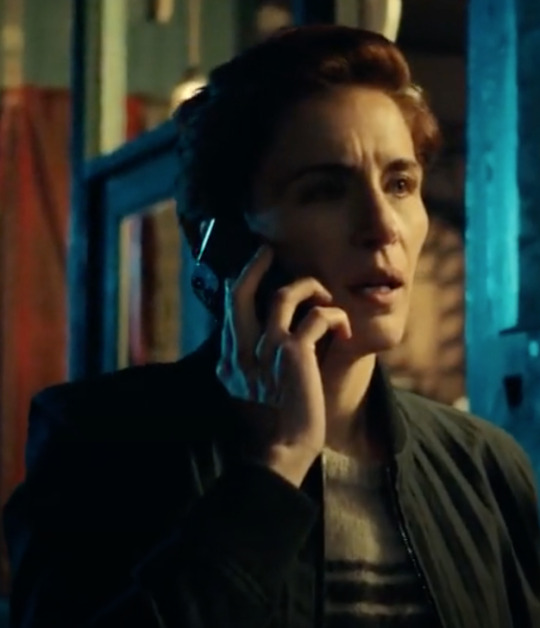
That night, Kate arrives at Frederico's to meet Jo, who calls her the moment she’s locked her car to ask to meet somewhere less public, for claims of privacy. Kate is immediately on alert, especially after her attempts to convince Jo to stick with the original plan. But after a small plea from Jo, she acquiesces, but not without caution. Kate immediately knows something is off - this is not how Jo interacts with her. Little do we know, Pilkington is skulking in Jo's backseat, coaching her actions.
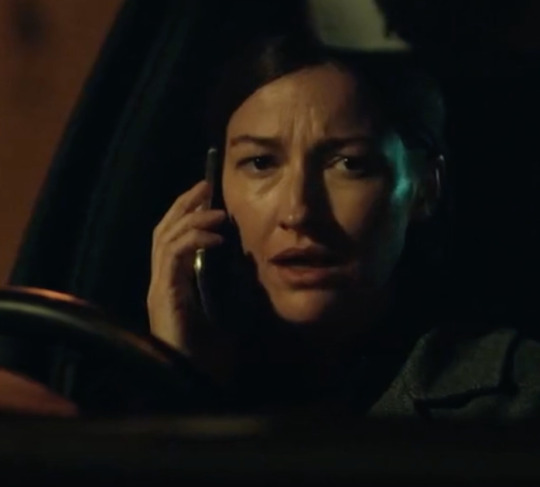
As an aside, this is also the only time we see them meeting out of work while they're both wearing casual clothes, not just the clothes they wore to the office.

Kate drives to the lorry park and calls Steve, because she's both an idiot and a genius. He’s wearing the same suit as before, grey with a navy tie. She learns that surveillance was pulled on Jo and Ryan, and explains Jo's odd behaviour, forwarding him the address. Unfortunately, their conversation is cut short by Carmichael, which immediately sets Kate on high alert and she ends the call. Just as Kate is about to leave, Jo pulls into the lot, and the tension escalates.

Steve receives the address and immediately informs Hastings and Chloe, ordering the team to get a unit ready. The team starts to rush out and Carmichael asks for calm, which Ted isn't gonna do when one of his people is in danger. AC-12 isn’t about to let Kate down.
At the lorry park, a distraught Jo gets out of her car and approaches Kate’s car. Kate tries to convince Jo to go somewhere else, but all Jo can say is that she's sorry. Kate is confused, but that goes away pretty quickly once an armed bent bastard steps out of Jo's car. He gloats to Kate, saying "Jo wanted to give you a way out. Should've put in for that transfer." Kate tries to convince Ryan to put the gun down, that the authorities will find him, but it doesn't work. Which is when Kate makes a gamble - she tells Ryan about the surveillance on him and Jo. Ryan tries to blame Jo for their situation, but she acts none the wiser (even though Kate told her about Ryan’s surveillance in the previous episode).
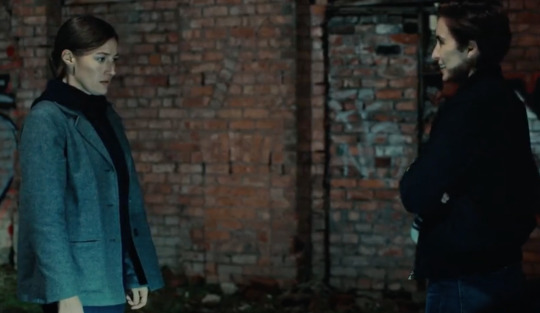
"Why would she come here otherwise?"
Sure, Jo is playing down her relationship with Kate for Ryan’s sake, but it isn’t quite that simple. Jo doesn't want to believe Kate had any faith in her. She wants to believe she was pretending, because she has no faith in herself. Her reaction does provide enough of a distraction for Kate to be able to pull her own weapon, and the most tense standoff ever begins...
One of the most key color choices of any outfits so far on the show are the clothes Jo and Kate wear to the lorry park where Jo sets up Kate to be killed by Ryan. Jo is wearing her grey coat, a blue sweatshirt, and a red top. Kate is wearing a blue coat, and a blue striped sweater with a band of red in the middle. These two outfits are ultimately the thesis statement between these two women. Jo is wearing red as her last layer, the one closest to her, but is surrounded by cool tones through her sweatshirt and coat. Meanwhile, Kate’s sweater has a stripes of red and orange surrounded by shades of blue.
But it doesn’t matter that Kate is being visually connected to Jo, because Jo is about to be responsible for her death via Ryan ‘the bent bastard’ Pilkington.
EPISODE 6
Nevermind though, no death for our beloved Kate!

Now, I’m going to take the next parts of the episode slightly out of order in order to tackle Kate and Jo together before their ultimate confrontation with Steve and AC-12. First, a run down of the AC-12 crew: Hastings is in full uniform, which represents his ultimate faith in the system, despite the bad actors and groups that try to destroy it. Carmichael is wearing a grey coat, aligning her with anti-corruption, but it’s piped along the edges with red, which shows how she’s opposed to AC-12 (though not necessarily corrupt). Steve is in his classic blue on blue on blue under his body armor, which shows his dedication to justice and also his faith in Kate. Carmichael confronts him directly about Kate’s whereabouts, which he fastidiously denies having any knowledge of, but unfortunately Hastings is forced to admit that Kate was permitted to carry a concealed firearm for safety. Steve doesn’t trust Carmichael, and this is shown back at the office when he tracks what Patty C is up to, mobilizing Hastings when she’s on the move.

At first glance, Kate and Jo’s red and blue outfits read as a visual metaphor for AC-12 closing in on their location, but I posit that these outfits are also indicative of Kate's belief in Jo, despite her anger that Jo has just set up her death. It’s clear at this point that their simple flirty banter from the beginning of the season has evolved into a deeper connection, which is part of what makes Jo’s betrayal so painful - Kate has been on her side the whole time. Jo just didn’t know it. [note: wrote this before the finale so guess who has egg on her face now…]
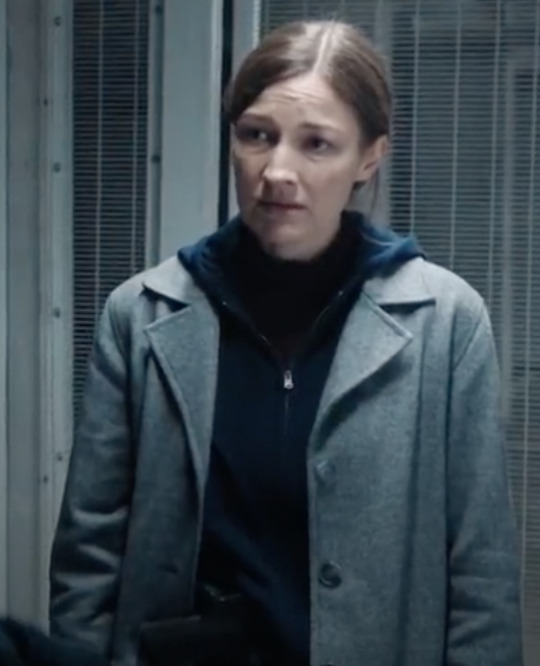
After a time jump (of nearly two hours, based on someone else’s analysis of time stamps and radio calls), Kate and Jo arrive at Steve's apartment. Jo asks if Steve can be trusted, and Kate leaves no doubt. Jo also asks why the surveillance got pulled, and Kate informs her about the chief and Carmichael. Jo denies having any part of it, but Kate isn't sure if she can believe her given the whole, you know, attempted murder thing. In a desperate bid to prove her loyalty to Kate, Jo asks for her gun, intentionally putting her prints on the murder weapon. Again, their coordinating outfits are the outward manifestation of their connection. Kate, while still angry, seems to accept what Jo is offering to her, but is clearly trying to maintain distance in the moment.
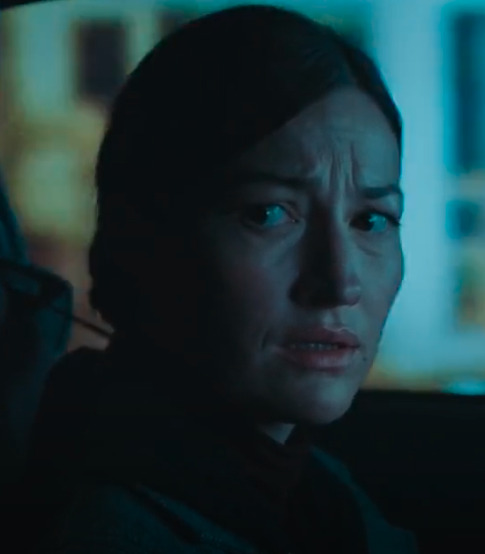
Jo then tries to see if things between them were real, but Kate refuses to entertain the conversation. What Jo is completely unaware of at this point is the lengths to which Kate has gone to prove that Jo isn't bent, up to and including risking a crucial raid on the OCG workshop. To Kate, it's a question that doesn't need to be asked, [the egg on my face remains] but Kate is also in disbelief that Jo would question her feelings when she's the one who was nearly killed by Jo. It’s an inappropriate time to have this discussion, and Kate lets that be known. They find Steve's personal car, a slate grey Mazda because this show is nothing if not subtle with its vehicular choices - even their personal vehicles tie in to their allegiance with AC-12’s mission.

Driving in Steve's car, Jo asks again if Kate was pretending with Jo, and Kate diverts the conversation away from herself. Was Jo lying to her when she hired Kate because she was ex-anti-corruption? No, she was hoping Kate, with her anti-corruption background, would stop her. Would save her, really. They discuss Jo's ongoing work for the OCG, and Jo's fear that she'll be killed if she turns, just like Tommy. She insists that she's not bent and Kate implores her to prove it.
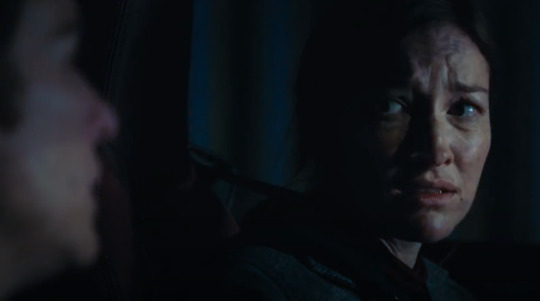
Kate is pissed [for the non-Americans, she’s very angry, not drunk…] in this scene, as she should be. She believed in Jo, she still believes in Jo, but she betrayed her in a major way. And now, when Kate is sticking her neck out for Jo again, she's still too scared to reveal what she knows. Jo does reveal that Tommy was her uncle, and that her father was a bent cop, which of course doesn’t align with what Kate knows. At Kate's further insistence, Jo directs them toward Gail Vella's house, and finally to the old print shop the OCG had used in the past that is across from Terry Boyle’s flat.
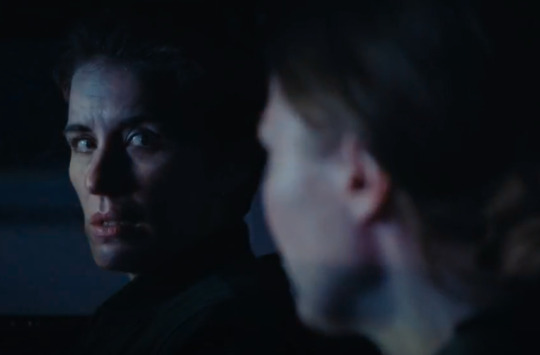
Kate and Jo arrive at the print shop, and Jo is finally about to reveal the truth to Kate. This act, coupled with putting her prints on the gun, earns Jo back a little bit of the trust she lost, and this is shown when the two women share the same shot. Most of the scenes between Jo and Kate have been over the shoulder shots where one woman is the primary focus, and this scene pivots to end with both of them together as the focus. This change happens in time with Kate dropping some of her much-deserved hostility toward the other woman.
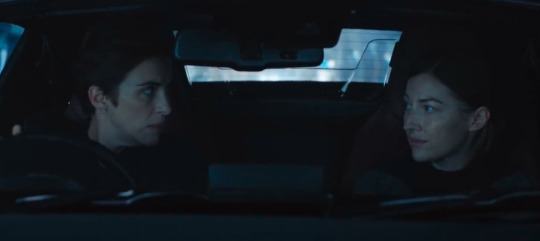
But before they can step out of the car, flashing lights and sirens appear behind them - they've been found. The fact that they've been tracked shocks Kate, but she spends no time dwelling as she throws the car into drive and speeds away. AC-12 AFOs have set up an intercept point, which Kate ignores in a truly badass handbrake turn, no matter if it makes any sense that they could have possibly known the route Kate would take in order to set up a kind of road block.
Handbrake turn or no, the Mazda has been intercepted and Kate and Jo are stuck. Kate is still confused that they've been found, but Jo knows the jig is up and tells Kate she's going to say she forced her to drive. It isn't until Jo tells her they have no other choice that Kate gets out of the car. Once out, Jo puts her hands up, but Kate refuses. Just then, AC-12 arrives with Carmichael, and Kate is in shock. "Jesus Christ, Steve's in on it" - cut to Jo's panicked face. This is the man Kate said they could trust, and now he's after them too.

What follows is a very tense standoff between the two fleeing detectives and AC-12. Jo surrenders, but Kate refuses. First Carmichael tries, then Hastings (at which point Kate tells Jo she learned some shady stuff about him), and then finally Steve walks up to them. Jo begs Kate to surrender repeatedly, but the DI believes she’s onto her second major betrayal of the night and she isn’t willing to give in that easily. She thought she could trust Jo, and she nearly killed her, and to her mind she trusted Steve and he turned her over to Carmichael.
Kate is prepared to tear him a new asshole, but he swears up and down that he has no idea how they got tracked, he wouldn't do that to her. Once he promises to get the two women into safety, Kate surrenders. As he walks them in, Kate shared Ryan's confession of murder and Jo's clue about the print shop. To the end, Kate believes in justice and will pursue it.
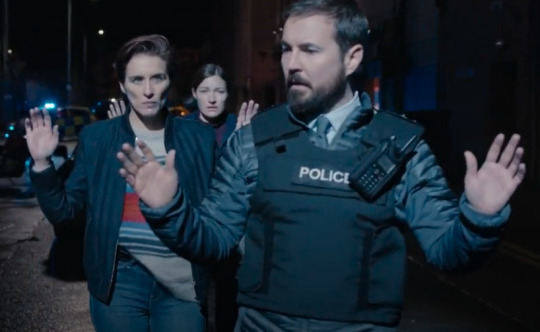
We then see a disillusioned Kate in her all grey Fruit of the Loom being walked into her jail cell. She sits down on the plastic mattress, looking at a total loss.
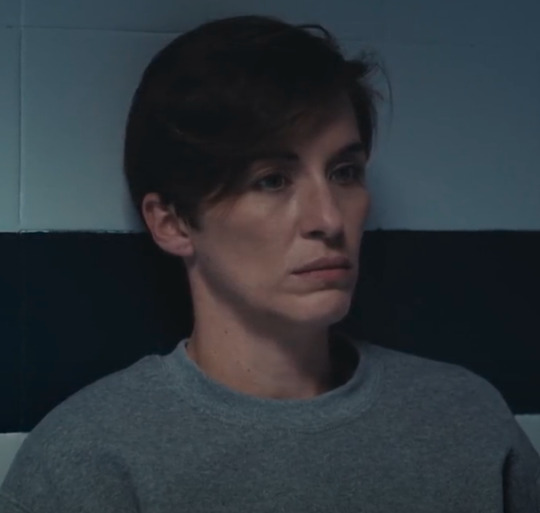
Later that night, Steve and Hastings are discussing the events of the previous few hours. Steve is in a grey suit with a blue shirt and tie, same as he had been wearing during the chase. The gaffer questions why Steve didn't tell him about Kate, and Steve claims it was to prevent putting him in a difficult position with Patty C, who walks in with the same question. Apparently, the former partners have keys to each other's houses and vehicles, in case of emergency. Carmichael taking Steve's phone would've read to Kate as an emergency. Steve refuses to back down, and she appears to drop it for the moment.

Now, onto Jo’s interrogation. A lot happens in this thirty minute scene, but to boil down to the important points: Jo is wearing her best Fruit of the Loom, stripping her of her identity and any affiliations she has. The lighting in this scene is cold and sterile, completely cool in tone. Steve sits with Carmichael and Hastings on the other side of the table, dressed in a navy suit, white shirt, and red tie.
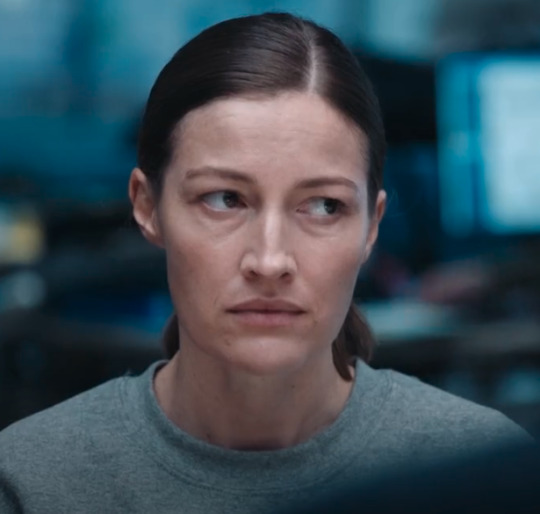
Something very important to note in this scene is Jo’s reliance on Steve. He speaks with her gently, acknowledges her pain, and encourages her to be truthful even when it is clearly very difficult. She takes Kate’s trust in him at face value and decides to trust him too. His outfit actually reflects this truth. He’s wearing the same red and blue that Kate and Jo wore while they were on the run - blue surrounds the red. As much as Jo is trusting Steve here because of Kate, Steve is being kind to Jo here for the same reason. His partner and friend does the right thing nearly always - if she was willing to go to these lengths to defend Jo, he owes it to her to learn the truth. Nothing exemplifies this more than when the conversation turns to Pilkington’s death.
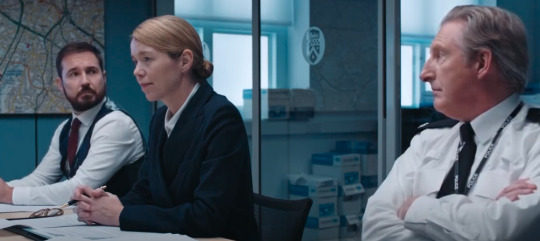
Jo refuses to answer at first and actually waits for AC-12 to show its hand first. She notices that Steve hesitates when Carmichael instructs him to talk about the evidence regarding Kate's gun, and she realizes this is her in, this is how she can prove herself to Kate once and for all. It's only after this that she claims to have shot Pilkington and completely shifts the blame from Kate to herself. This catches both Steve and Hastings up, and they react in obvious shock, which changes how Hastings treats her through the rest of the interview and cements Steve’s belief in Kate’s trust. Afterwards, she looks to Steve, who nods. He understands what she just did for Kate, and Jo is relieved to see his comprehension. The questioning continues, and Jo only admits to what she can take direct responsibility for, but nothing that involves the larger network.
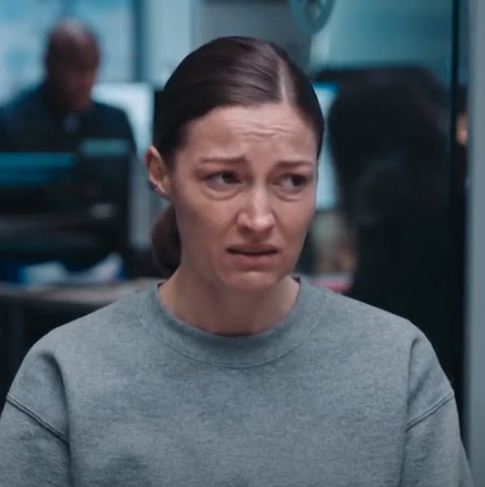
Once Carmichael and Hastings leave, she quickly turns to Steve and says a desperate "I'm so sorry." Sorry for hiding evidence in Operation Lighthouse. Sorry for framing Farida. Sorry for what she’s done to Kate.
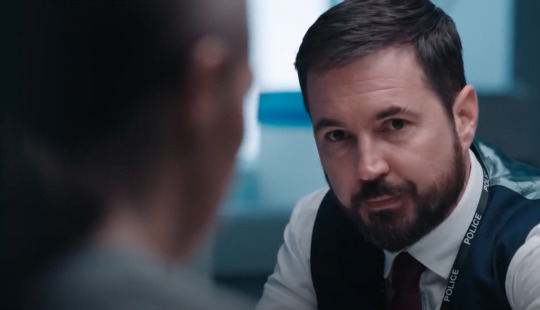
And Steve, gentle when he can be, gives her a kind "Yeah, me too," in reply. I’m sorry you were groomed into the OCG. I’m sorry you were scared for your life. I’m sorry you hurt Kate, too.
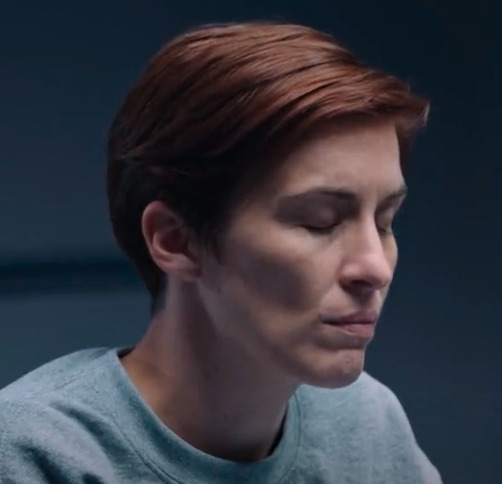
Patty C goes to talk to Kate, and lets her know she won't be charged for Ryan's murder - Jo will be. Kate has a look of relief on her face as she processes the information. But Patty C notes Jo isn't firearms trained, and Kate is. She's telling Kate she knows what really happened, and she's letting it slide. This time. Kate is well aware that Carmichael isn’t stupid - she knows Jo was lying and is only letting Kate get away with it because it better serves her interests. Kate is free, and she sighs with relief and the knowledge of what Jo did.
Steve, still in the same outfit from the interview, and Kate, in a navy pea coat and yellow sweater, meet in an underground car park. once she's been released. A quick note on Kate’s coat: I’d love to say there’s a deeper meaning for the shift in her coat, but I genuinely think it’s just because filming was originally in the spring, then was moved to the fall and continued until November, so it was simply colder. The cut and color of the coat are generally the same, despite the style changing.
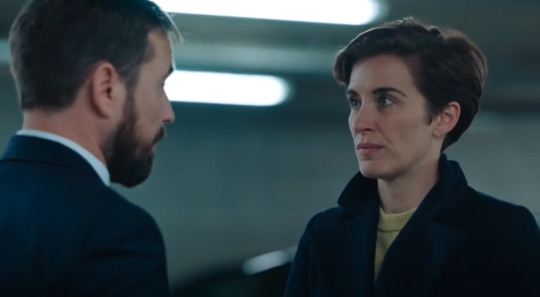
Steve offers to lend an ear about the shooting, and then Kate asks about Jo's interview. Steve tells her they didn't get enough information out of her, and Kate tells him that Jo told her that her dad was an officer. "She's scared, Steve. After what happened to Tommy, Dot, Lakewell, nevermind John Corbett". Kate’s anger seems to have dissipated at least a little at this point, because here she is, defending Jo by explaining why she wasn’t forthcoming with a lot of information. This is most obvious through her yellow sweater - still affiliated with Jo, even through everything else. Steve lets her know that Jo is in a secure cell with extra monitoring, which seems to appease her. Kate then informs him she's been made SIO at MIT, and will guarantee cooperation with AC-12. Lomax calls Kate, and the two partners are back working together.

Kate and Steve meet Lomax at the OCG workshop, where he goes over the forensic findings so far as MIT’s resident plot reciter. Kate tells him they need to look further, and orders him to dig up the floor, ruining the poor man’s plans for the evening.
Chloe calls Steve with an update on Thurwell. Then we get a weird scene of darkvision Spanish police apprehending Thurwell. Truly hate it. He's dead. It's a deadend. Clever writing, Jed.
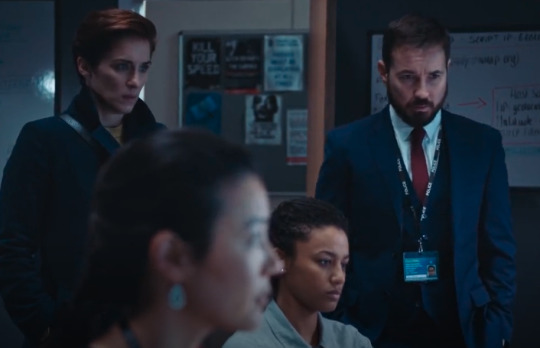
The episode ends with Jo in her navy blue jumper being put into her cell at Brentiss. Tweedle Dum and Tweedle Dee, Lindsay Denton’s besties, walk up threateningly before Jo is led into her cell and the door is shut. I do love the shot here of Jo through the door, caught in a small tight space that’s almost closing in on her.
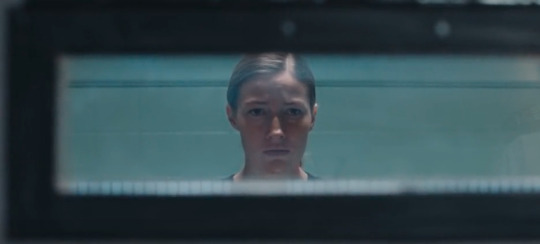
EPISODE 7
Before I fully jump into Episode 7, please be aware that I am doing a textual analysis. I’m not going to go into the fourth man reveal and its logic or even greater meaning (particularly because I’m looking at this show from a different political context as an American), and I’m not going to speculate on things not seen, at least in this analysis, because the focus is on wardrobe. You can trust I have many thoughts, particularly around race and the writing around female characters, some of which I’ve included but most of which I did not. It took me 9 full days to write everything for this one episode, and was shockingly exhausting. Forgive me if it doesn’t live up to my other ramblings.
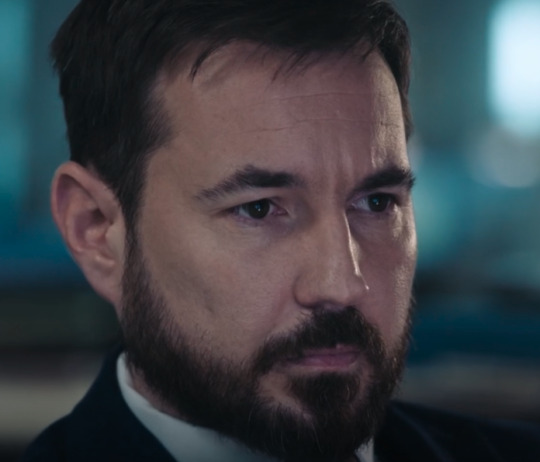
We’ll jump right into things. I'm gay but Steve looks so good here in his AC-12 uniform. Anyways, Steve is watching Hastings' old interview with Carmichael about Ian Banks. His concern about Hastings is clear. He’s in pursuit of justice, even if justice puts him up against the gaffer.

Later, Steve and Kate discuss the gaffer and his suspicious behaviour, and he informs her that Ted is slated for retirement. Steve wants to let it go, but Kate refuses. She asks if Steph Corbett knows anything more, and suggests she may be blackmailing Hastings, but Steve is dismissive of it. This causes Kate to raise an eyebrow - oh god Steve's done it again. Steve pleads "It's not like that, mate, it's different," and Kate has never looked more disbelieving and annoyed. She responds, "She's a person of interest,” and their conversation is cut short when Chris calls Kate with an update. Steve is still in his navy suit, and Kate in her yellow sweater. The lack of coordination in these clothes show Kate isn’t quite on the same page as Steve yet, but they’re getting there.
Lomax tells them there was a case found in the floor of the workshop, much like the one holding Gail Vella's computers at the abandoned print shop that Jo led them to. No comment on the OCG’s evidence techniques.

Steve, who kept skipping his occupational health warnings, is in therapy. I didn't cover the OH stuff throughout this analysis since it didn't relate to Jo, but this manages to tie in later so here it is now. It ends in him agreeing to temporarily give up his firearms license. I'm not going to discuss the rest of the meeting, given that Steve seemed to kick his pill addiction and reliance on alcohol and pain relievers to deal with his back pretty damn quickly and it's a storyline of entirely no relevance except as something Ted holds over Steve in a moment of manipulation later. Steve also admits this to Hastings before Occupational Health can tell him. This entire storyline is frustrating. Moving on!
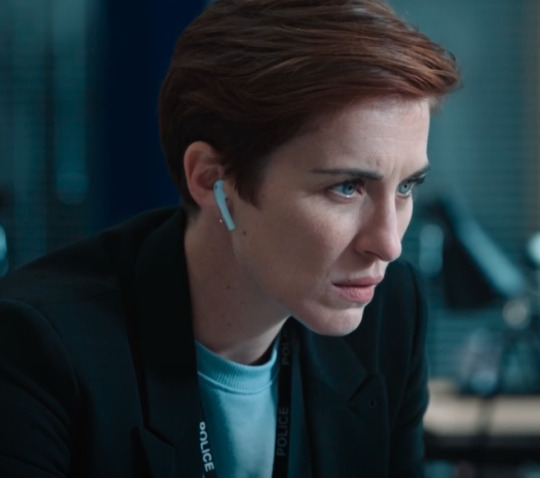
Kate is watching Jo's AC-12 interview at her desk on the Hill, specifically rewinding to parts concerning who Jo believed her father was. She pauses it on a frame of Jo’s face, the terror clear. Kate is dressed in a black suit and a light blue shirt, back on the side of AC-12 and in pursuit of justice, not only with regard to the OCG, but for Gail Vella and Jo.

Steph calls Steve again, and he ignores it, because he's being a bit of a dick. Then he steps out of his car and has a back spasm. This only comes up so Kate can ask about it later and show that Steve, wearing a blue jacket, listened to what she said about getting close to a person of interest. Would truly love to know why Steve parks by an underpass by a river for this scene, but needs must, I guess.

Back at Hillside, another Lomax briefing! Because Chris, Chloe, and sometimes Kate are truly the only people who do any detecting in the entire series!!! Anyways, Chris tells Steve and Kate about the contents of the box under the floor of the workshop. Conveniently, it held four murder weapons (can Jed Mercurio spell deus ex machina?) and neatly tied a bow on Corbett, Bindra, and Vella's deaths, and in a nice series 1 throwback, Jackie Laverty's murder! Kate is wearing a grey turtleneck which coordinates beautifully with Steve’s grey suit, blue tie, and blue shirt. This shows that they’re back on the same page and on the same team, despite their ups and downs this series.
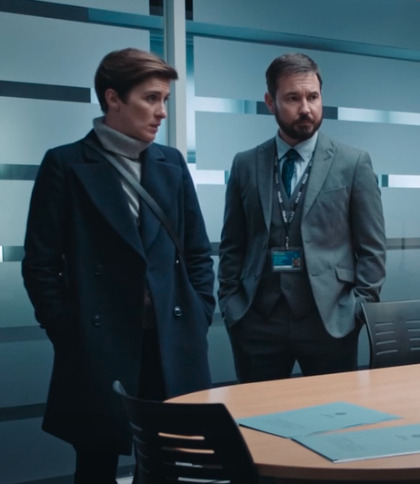
Kate and Steve return to AC-12, where Kate in her new navy pea coat shares that the proceedings against Terry Boyle will be stopped. Except, to my knowledge, Jo already handled that...? They literally made a point of it in her interview. Anyway, Chloe, like Chris, did all the detective work and tells them that the IP of the OCG laptop is in the UK, not Spain as previously believed. Amanda from forensics, the only other person who does any real work, interrupts with a message that shows Jo is about to be targeted. Definitely is spelled wrong. I give up. They feel the need to spell out what JD and BP mean, but spend 3 episodes never explaining what a CHIS is. Sure. Chloe is tasked with finding the fourth man via spelling.

Also I'm truly not being funny by why is Kate on the investigation board in AC-12. Like. What. Was she a suspect? She’s not with the other victims!
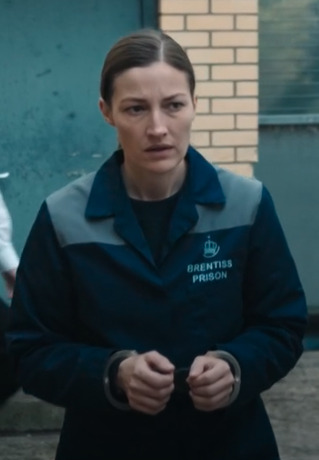
A very forlorn Jo in her blue Brentiss jumpsuit is sitting in her prison cell before being collected for transport to Hillside. Jo is very aware that something must be wrong because she’s a damn fine detective. She's mad suspicious as they head out to the van, and lo and behold, Tweedle Dee and Tweedle Dum are on the transport team.
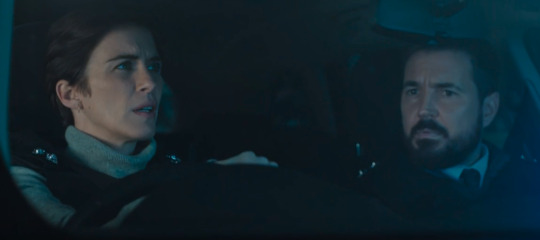
En route to Brentiss, they learn that Lomax and Kate's signatures were forged on the production order for Jo. Meanwhile, Jo is too smart for her own good, and questions the guard during the transport about the requesting officer. Tweedle Dee plays dumb.
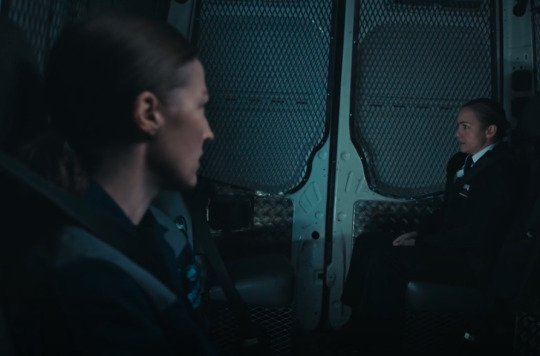
And then… nothing happens. They intercepted the van in advance, removed Jo, and planted Steve and Kate on the van. Because Steve is such a great choice what with his being an UNARMED OFFICER AT THE TIME. They arrest everyone. Steve ends up with a gun. Ok.
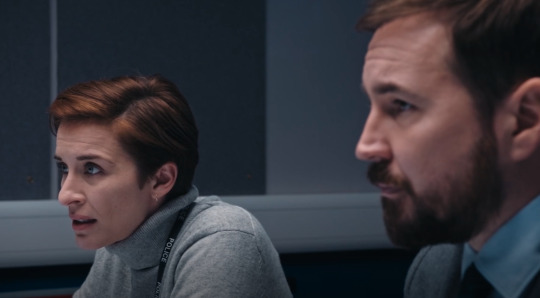
In an interrogation room, Kate and Steve explain what happened to Jo. Hastings looks on. Kate tells Jo she can apply to witness protection, and that all of her notes will show that she was under coercion from others, giving her a shot at the life she never had, but only if she reveals who the top man is, aka her father. Jo begins to cry, and Steve reminds her those OCG men were sent to kill her - this man doesn't care for her. Jo begins to tell them that she had no reason to believe Tommy was lying to her, all while speaking only to Kate. Steve encourages her further, telling her she's not bent. Kate asks her one last time for the name, and we see Jo resolve to say something before the scene cuts. Heaven forbid we show something happening instead of faking built suspense.
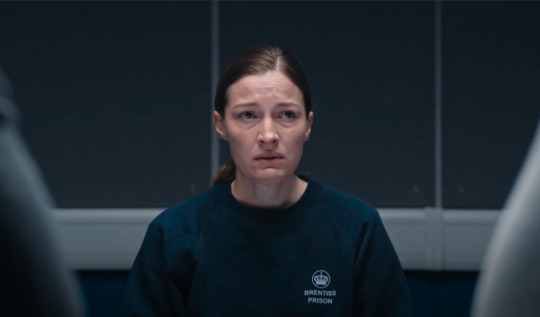
Now, I need to pause here for a small moment of rage. Kate should have been the one who got the call back line by telling Jo she's not bent. Not for any romantic reason, but because their little run from the police stunt was done at least in part under the auspices that Jo could prove to Kate that she wasn't bent. In fact, Kate pleads with Jo to do so. It's just frustrating, and gives Steve an emotional beat he hasn't truly earned with Jo, or at least hasn’t earned as much as Kate.

And Jo gives them a name! They search a prison cell, and find nothing. It's really built up to seem like it's Fairbank, who is revealed to be a confused old dude. Why Jo thought she was communicating with him this entire time is simply never addressed. Whatever. They ask about the murders and cover ups, and he offers nothing. Kate asks about Jo, and after some more pushing, Fairbank implicitly agrees that he and Tommy Hunter convinced Jo he was her father. Hastings is pissed, but Chloe calls to save the day (again).
Chloe "I should be Chief Constable" Bishop brings the team up to speed on the text search for incorrect spellings of the word definitely. Which they've apparently managed to do in a matter of hours, even on handwritten reports from 17 years prior! Because Jed has definitely never needed to do a text analysis by hand before. They then proceed to NEVER NAME THE SUSPECT. FOR 1 MINUTE AND 10 SECONDS.

Oh but don't worry, because this is the perfect opportunity for our realigned partners to confront Hastings about the bribe money and his conversations with Ian Banks. Can't reveal who the fourth man is when the head of the investigation is also a bent cop, silly audience. And it's revealed that Ted leaked Corbett as a UCO because of Corbett's role in the attack on Hastings' wife. But it's okay because he's sorry about it!
To be hella clear: Hastings, an anti-corruption officer who prides himself on following the letter of the law, took actions he knew would result in the death of John Corbett and Kate later forgives him for it. Jo was under threat of death from the OCG and tried to get rid of Kate via transfer and then led her to an empty lorry park to be killed while she thought Ryan was under surveillance that could likely intervene, and we in no way see Kate react to that experience in this episode. Cool!
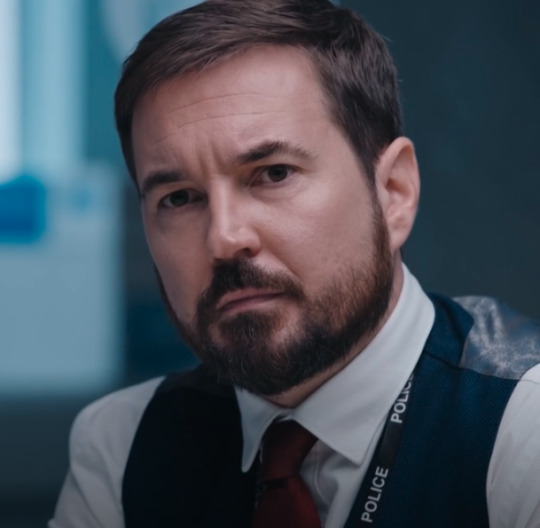
Finally, we get the interview with the fourth man, which is revealed 8 minutes and 32 seconds after the characters themselves learn the information. For some reason unknown to God or man, Kate is there despite not being involved in Buckells' case since she works for MIT, not AC-12. Frankly, not gonna delve into it. Kate is wearing a sweater we've yet to see her in, a blue crew neck that is frankly more feminine than anything we've seen this series so far, and moreso matches what she's worn in previous series. It’s unsettling. Steve is in his classic AC-12 uniform.
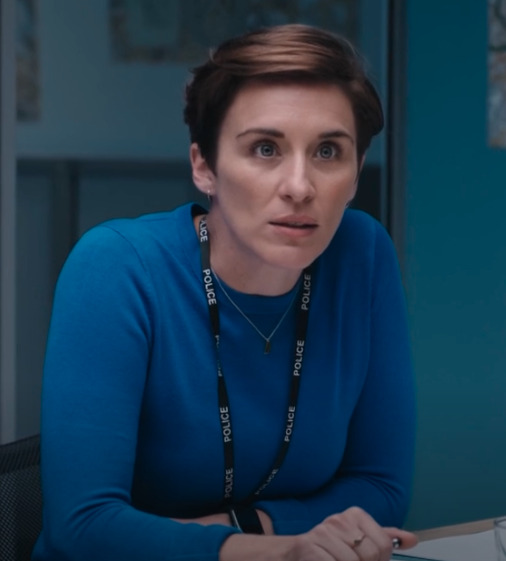
Just a quick q for the kids at home - if Buckells only ever communicated with people via a secure browser on burner devices, how in the hell did he get a laptop in prison? Also, why did he not break himself out of prison by having someone else plant evidence of some kind, especially since he supposedly had a lot to blackmail Jo with?
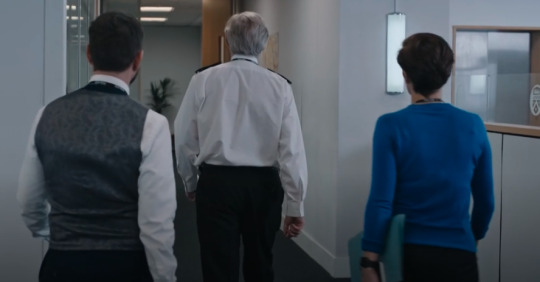
At what I can only assume is their local, Steve and Kate congratulate themselves on doing nothing beyond sit in interview rooms to catch Buckells. Kate might go back to AC-12 - even though she left because of the gaffer's actions which turned out to be WAY WORSE THAN SHE PREVIOUSLY BELIEVED? Sure, Jed. They have a chat about what's been happening with Steve and his painkiller addiction. Kate implies he should drive up to Liverpool to see Steph, which he doesn't think is a good idea. But don't worry, they've got each other, mate. Platonic soulmates forever (no romantic underscoring in this analysis).

And then, with no previous discussion in the script or even telegraphing by the camera, Kate is in therapy. Which is great, because she truly needs it, girl has been through a lot. She mentions her ex, and Josh who is apparently her reason for living but she's texted about him once and mentioned him offhand to Jo to tell her he'd be with her ex, and then her great friend and partner, Steve (which is true, but the romantic framing is gross and out of character).

Not being funny, Kate is wearing a truly horrendous mauve top here, over a white shirt. We've never seen her in a color like this, it doesn't fit in with the rest of the color palette in her wardrobe, up to and including all of the orange and brown she wore at MIT. It's honestly frumpy, and in no way aligns with the characterization shown to us through her wardrobe in the rest of the series. The last time we do see her in an outfit like that is during the interview with Jo. Jo left and took Kate's excellent sense of style with her.

Kate and Steve meet with Patty to discuss Darren Hunter's involvement in the murder of Lawrence Christopher, and discuss how there's more corrupt officers to be uncovered. Patty C isn't gonna do anything about that tho. Hastings strolls up to chat with Patty C, and we learn that Buckells will get immunity. The trio are about to leave when Ted storms back into her office to confess to his actions leading to John Corbett's death. He gets one more speech about carrying the fire and bad apples in policing before they all leave.
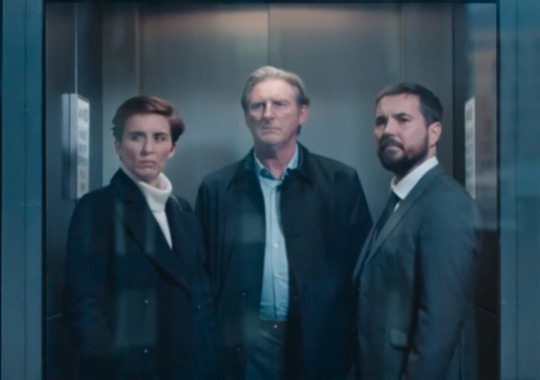
For the final outfits we may ever see them in, Hastings is wearing a blue shirt, Steve is wearing a grey suit, white shirt, and green tie, and Kate is in a white turtleneck with a navy pea coat. Again, this turtleneck is more effeminate than anything we’ve seen her in this series. Hell, even Patty C is wearing blue to show she’s aligned with anti-corruption and just kind of a bitch, not actually corrupt.
Finally, to the blessed epilogue. Shoutout to Terry and Farida for getting some closure to the bullshit they’ve been through.
Jo steps out of her little stone cottage in the country, dressed in a casual sweater of grey and blue, breathing in the fall air deeply. Her layers of clothing are gone, her hair is down and soft. Her Icelandic sweater shows that she’s finally free to honor her heart, and no longer feels trapped by her family and who she thought they were.

And then, a dog trots out after her, and we see Jo bend down to hug the retriever and kiss its head. This is the most free affection we have ever seen Jo give. A set of legs appear in the doorway behind her, and a redheaded woman steps out of the cottage to meet Jo and the dog. Jo smiles at her, oh so freely after the tension she carried for 21 years, and they clasp hands, walking down the country road away from their home. Because Jo is free, and she can freely love and live without fear in her new life.

Now, from a purely logistical standpoint, very little affection between anyone could be shown from episodes 3-7 because of COVID filming protocols (which seem to be far more strict on physical distancing than American and Canadian productions). The production team actually did a brilliant job using forced perspective and interesting over the shoulders to make people seem like they were closer together than they were. From a film nerd perspective though, they broke the 180 rule so frequently that I nearly lost my mind (glass boxes are great but they ignore all rules of perspective).
All that aside, the logistics of filming in COVID mean that moments where we do see physical distancing broken are all the more important. Kelly filmed this scene with an actress who she has not been working with for months, because it is so, so important to see Jo come out of the other side of her tragic life intact. It also matters that her partner is wearing a warm hat and has red hair (intentional casting or otherwise) and that their home has a red door, because it shows that those warm tones represent something different for Jo now. They don’t represent fear and betrayal and being trapped - now they represent home.
Additionally, there are a lot of comparisons made between Jo, Dot, and Ryan. All three had been groomed by Tommy Hunter since childhood to work for the OCG, all three were put into the Central Police to act as inside men, and all three committed terrible acts in their own interest. But there are differences here. Ryan was a little shit as a kid and he clearly had a terrible home life - his mom was the worst. He gravitated to an authority figure who offered him something different and who gave him power. He is a victim of circumstance - but he also found power and enjoyment in his terrible actions. He gloated about Maneet Bindra and John Corbett’s deaths, and he enjoyed wielding power over Jo when he was threatening her.
Dot is the blend between Ryan and Jo - he too was groomed by Tommy to enter this world of crime, and did many awful things without regret, including killing people who threatened to expose his identity as the Caddy. It’s not until his friendship, and burgeoning relationship, that his behavior changes. He almost gets away from the Central Police, despite Kate hopping on a lorry for a free ride to track him down, but when faced with the reality that this would mean Kate’s death, he sacrifices himself and gives her a final clue to dismantle the OCG within the police.
Jo, from what we’re shown, felt regret after everything she did, and the show made it a point to demonstrate Jo as a victim of her family and genuine fear for her life if she didn’t continue following the actions of the OCG. We never saw Ryan or Dot with a gun to their head or with a dozen locks on their door. We never saw them break down in bathroom stalls, or even framing people and discrediting them instead of killing them. And it’s ultimately her relationship with Kate that changes things for her - she tries to use Kate at first to get caught, and when they get close she tries to push Kate away in order to protect her, right until she thinks she has no other choice but to let Ryan kill her.
It’s interesting that all three characters meet their end with Kate (and a damn shame the show never chose to address that fully). She quite literally kills Ryan, has a standoff with Dot that ends with him sacrificing himself for her and giving a dying declaration, and goes on the run with Jo to give her time to prove she isn’t bent and who plants evidence against herself to protect Kate. Later, it’s Kate who convinces Jo to give up everything she knows about the OCG and the man who claimed to be her father, and Kate who offers immunity and witness protection. Finally, in their last scene together, Kate manages to save one of the people corrupted under the thumb of the OCG. She completes a task she first set out for in series 1, the first time she interviewed Ryan and tried to get him to realize there’s a better life out there for him.
Kate does what Jo was hoping she would: she saves her, and gives her the life she never thought she could have.
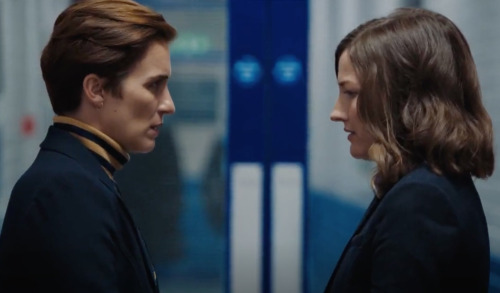
I wish I could end this with a perfect bow that ties the wardrobe threads of this series together, but frankly I can’t. On a macro level, cool tones remains the symbol of anti-corruption and the pursuit of truth and justice, and warm tones represent any force opposing those ideals. On a micro level, Steve’s clothing choices and what they represent remain consistent throughout the series, as do Jo’s. However, the character that ties Steve and Jo together, the person who believed in the truth of Jo despite what face value was saying, that person’s wardrobe gets thrown to hell in the final episode. Kate’s colors remain cool, and it’s understandable that the warm tones that represented her connection to Jo disappear as Jo turns on the OCG, but the actual physical clothing is completely different from what she’s been wearing before and doesn’t fit her characterization.
I think it’s crucial to note that her femininity is only played up when she’s back on a team with men, where her earlier androgynous dress became suddenly unacceptable. It’s a damn shame, because the emotional payoff for Kate’s growth outside of AC-12 could’ve been really spectacular, and she was stymied in the end in favor of her male colleagues.
#line of duty#kate fleming#jo davidson#steve arnott#flemson#kate x jo#lod spoilers#line of duty spoilers#It took me a long time to finish this because I struggled with the absolute 180 degree turn the show took tonally in the final episode#It honestly threw off quite a few of my conclusions#and I had to rethink the analysis#but thank you to everyone who stuck with me#enjoy!
41 notes
·
View notes
Text
The Dream smp will have a bad ending (And why preparation beats improvisation)
So. I am back after a little while. And this is a topic that has been on my mind for a long time. But before we get to my main point we have to clear some things.
The medium where a story is told dramatically affects the story in many ways. A story cannot be the same in a book, or a film, or a tv show, or an anime, or a comicbooks. They are all different mediums that have their own positives and negatives when it comes to telling stories. A book can fit more information but a tv show can have music and good camera work, etc.
Now, the Dream Smp is a completely different thing. This is a medium that has (I think) never been used before (Or at least not at this extend). And as all mediums it has its positives and negatives. The positives are very clear, strong and interesting: You can watch multiple POVs, follow the storylines you care about, you can see events from different perspectives and see whoever your favourite streamer is as the main character. And all of these positives are amazing and unique. No other medium has something like it... but it also has negatives no other medium has. As I see the Dream Smp has three big flaws due to it’s medium:
First of all, real life sometimes gets in the way. In books, movies and tv shows you can just pretend life does not exists for the duration of the episode or movie. This is called escapism, the reason why storytelling is so attractive. The problem with the medium of the Dream SMP is that the storyline sometimes is affected by real life in ways other mediums aren’t. For example a streamer deciding not to do roleplay after a big event when we could use a nice view of the after-effects of said event, or a streamer missing an important event that they could have been a major part of. And this is not the streamer’s fault at all. Real life is inevitable. An example is when Wilbur missed the festival because he forgot to read the groupchat. But it is still an unfortunate negative of the medium.
Second, improvisation can be great. But it can also... not. It is a miracle, a truly testament of how good everyone’s improvisation skills are that the story has been so good for a long time (As I have said in prior post, the story is basically flawless until the manberg/pogtopia war. Then it all kind of went downhill). But I think it is starting to show that preparation beats improvisation 9 times out of 10. Improvisation only works when people have a small guideline, something that tells them point A and point B for them to connect. And I don’t think that is happening a lot nowadays. Furthermore, I don’t think the current writer are doing a good job of communicating the plot to other and including everyone. We can see this in many ways: Nicky not knowing about the festival until the day before because of her chat, Dream leaving Techno on read when he asked what the next plotline was, Tommy not reading the scripts, the story becoming more and more the “Tommy and other two people show” instead of the “Dream Smp show”, and many other examples. (I have many thoughts about how I feel like Tommy sometimes is grabbing all the story/clout of the SMP for himself, not on purpose probably, but... I just feel I bad vibe from that. It is not something I can really put into words. Just a feeling. Not accusing him of doing that or being evil or anything. Just an unfortunate side-effect of him being the center of attention all the time which can lead to fatigue from the viewers when the plot is always about one guy and his discs all the time)
And finally the main negative. The biggest problem and challenge the SMP will have. It’s ending: It is not a secret that the SMP is successful, popular and makes a ton of money. So of course they will continue the SMP. But the problem is that the smp has a story and stories can only go so far. For example, Tommy’s discs being a motivation for his character for one or two arcs is understandable. But when the discs are his motivation for several arcs (And counting), it kind hurts your suspension of disbelief (That is the amount of things you can take in a story before you say “This story is not believable at all”). I am not comparing the smp to Disney. But when they continue to stretch the story more than it should because it is successful... yikes. The manberg/pogtopia war could have been the finally if they changed around a couple of things. And I fully understand them wanting to continue the story after that arc (Which I agree was a good idea despite their not so successful attempt of replicating prior arcs). And the point where we are now although kind of weird, I can totally see the story continuing. But there will be a point where it just feels like everything should have ended long ago. You cannot have a character go through the same arcs, the story having the same events all the time. Writing a long story is hard and complicated, you have to justificate why there is more all the time.
And if they don’t start organizing better, including everyone, planning things out, and deciding on a satisfying ending... then the Dream Smp has a will have a boring repeated ending that few people will watch because it will happen when people start moving on from the smp. And I really don’t want that. They should quit when they are ahead, when they feel comfortable ending the story, when all arcs are resolved, before things start going even more downhill.
PS1: Again, english. Sorry if i’m a bit negative on my blog. But there are already thousands of people explaining an analysis all the amazing things from the smp that I would just be repeating what everyone says. Criticising something you love is not a bad thing. I see as your love for something is so big that even with flaws you can still love it... that sounds corny, jesus christs it is just minecraft roleplay. As always, I am never sending hate ever.
PS2: Something irks about Tommy and Tubbo not streaming together almost at all even though in the story they are friends again. That and Tubbo not being on any of Tommy’s videos but other are just... It is probably nothing... probably. Maybe it is just me projecting my own insecurities with my own friends. I am not saying they had a fight or they hate each other now or whatever. But... it’s still a bit sad and weird. Maybe it is because Tommy only wants to do content with like big youtubers and he is focused on always improving and stuff, while Tubbo is more about relaxing and streaming shit he enjoys. A shame. After months of no content from them, they are back but not really.
PS3: Nothing has happened story wise at all since Doomsday. Which is odd. Is Tommy moving on from the smp? He did say he is focusing on youtube at the moment (And unfortunate negative of the medium, real life gets in the way of the story as I said) so maybe it is that. Nothing major has really happened. Not even small things. Why is Tommy streaming less and less all the time? I don’t know. I also do not think there will be an event on the 16th because of the chess tournament and the lack of any plot developments at all since Doomsday. Many questions, few answers. I kinda feel like I am getting a bit tired/moving from the smp. And Tommy specifically, I am glad for him and happy that he is getting all this success but I think his persona made more sense/was more bearable when he was a relatively smaller streamer/youtuber. With the risk of sounding corny again... I feel like Tommy is too mainstream now (Tiktokers are commenting on his instagram posts and that is never a good sign) and has become more corporate (Only streaming and making videos with people who benefit his video’s/streams instead of HIS BEST FRIEND TUBBO. But that really could just be my anxiety talking. Don’t think to hard about it, I am no one to say what he should or should not do, and I do not know of his life to say things definitively. Just a hunch, a bad vibe I am getting from him.).
#dream smp#dream#tommyinnit#tubbo#wilbur#wilbur soot#jschaltt#nihachu#Nicky#fundy#eret#ranboo#philza#QUACKITY#badboyhalo#SapNap#georgenotfound#skeppy#antfrost#technoblade
80 notes
·
View notes
Text
A look into Killing Eve’s S3 photography: Camera Angles
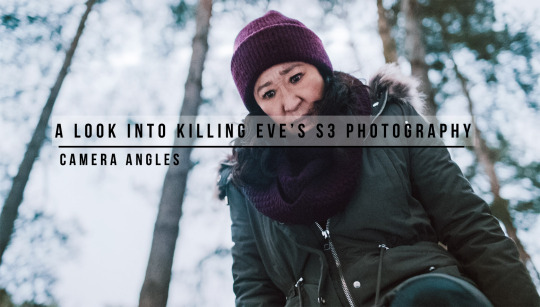
"A film is never really good unless the camera is an eye in the head of a poet” - Orson Welles.
Last time I talked about the rule of thirds and the importance of making the audience experience the character’s feelings through the framing and composition using the rule of thirds.
This time I’m going to talk about the most important camera angles used in the show to help telling the story.
Zoom vs Static Shot
With the zoom effect, the frame itself is “moved” by adjusting the focal length of the lens through the duration of the shot. It magnifies what’s in focus without changing the perspective of what’s in the frame, it compresses the background, which serves to pull your eyes even closer into the subject.
We see an example of this technique for a few seconds during Villanelle and Hélène’s meeting in episode 7. In this scene, Villanelle seems about to answer Hélène’s question “Do you have anything you would like to get out of your chest?”
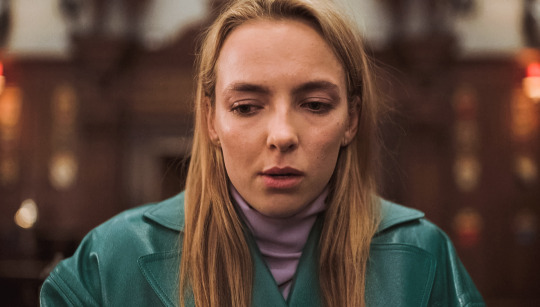
This zoom effect can make a character seem more powerful, but at the same time the compression effect can make it feel like the world is closing in on them, making the viewer feel trapped and claustrophobic. The zoom can also draw us into the feelings of a character by focusing on their expression and isolating it from the scene.
My interpretation here is that it makes the viewer feel interested and somehow nervous about what her answer is going to be. Is she going to say anything she shouldn’t?
Now, what happpens if the camera does the opposite thing and it doesn’t move at all?
Let’s keep in mind this hard to forget scene from episode 5:

Sometimes what’s happening in the scene is all that’s needed to tell the story. The lack of movement from the camera draws the attention of the audience deeper into the action and intensifies the feeling that they are experiencing.
I think we can all agree that this short scene is one of the best in the whole season and thanks to the static shot, the interpretation, the fact that we can’t hear the music and that there’s nothing that distract us, it makes it an unforgettable scene that gives such a haunting feeling difficult to move on from.
High and low angles
This technique is seen in the series all the time, certain characters are almost always shown with the same high or low angle. Why is this? In the case of a camera shot from a low angle it conveys power, and inferiority if the character is shot from a high angle.
So, who does usually get filmed from a low angle?
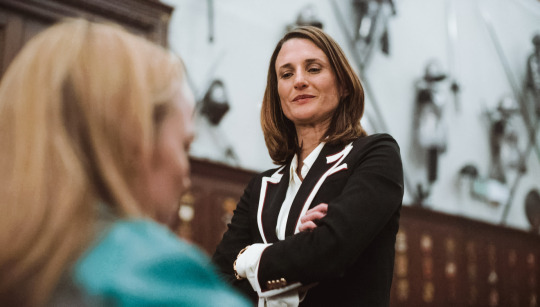
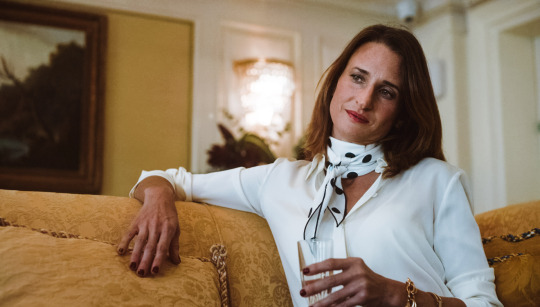
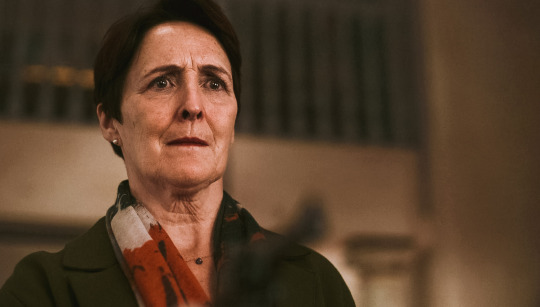
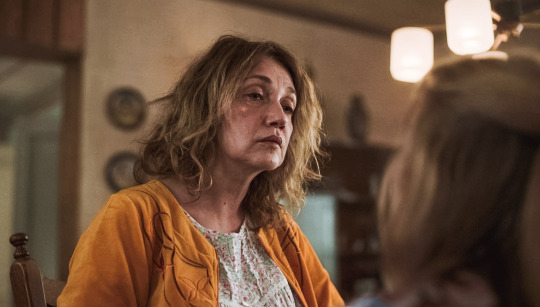
See the pattern here? It really builds power.
A dominant or powerful character will be shot from a low angle, forcing the viewer to look up at them. While on the other hand, characters that are in a position of inferiority are shot from a higher angle. It forces the viewer to literally look up at the dominant character and look down at the inferior one.
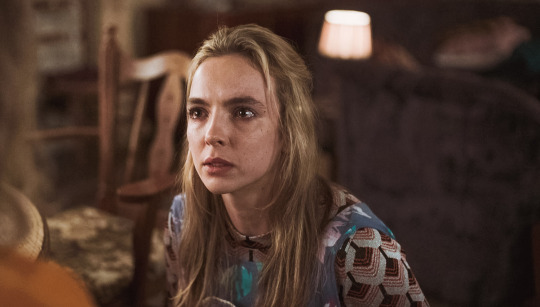
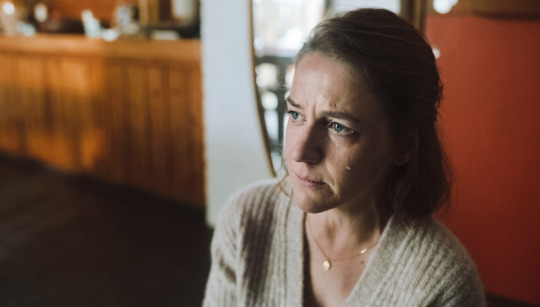
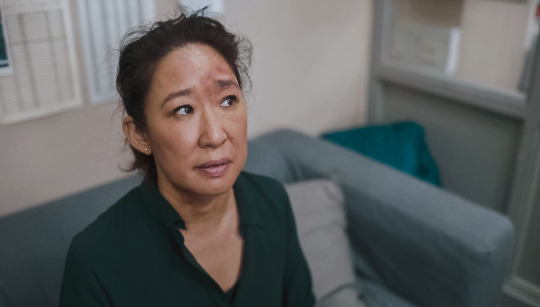
Now, this doesn’t mean that every character always gets the same camera angle, of course (except for hélène who gets the same type of angle 99% of the time, because well...she’s kind of the big boss, right?). It depends, once again, on the narrative of the scene.
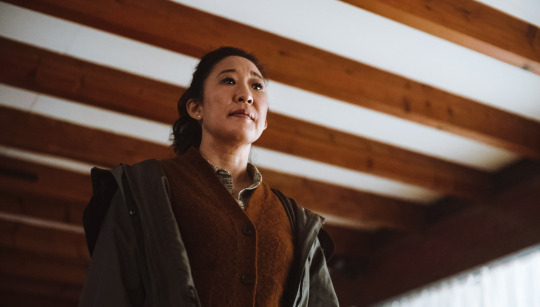



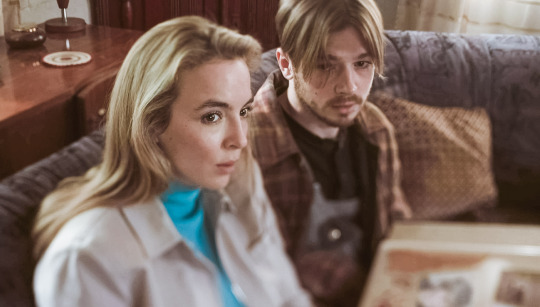

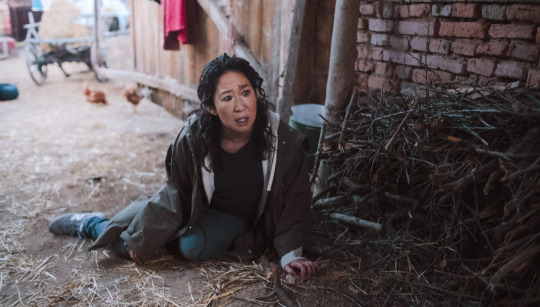
Let’s get into something even more interesting now...
Camera angles varies all the time, and as I said before, it goes along with what the scene is telling us. Let’s take an example from this one in episode 6:
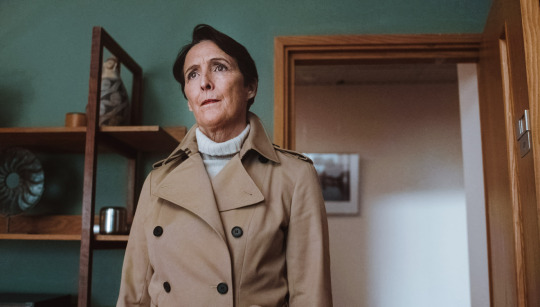
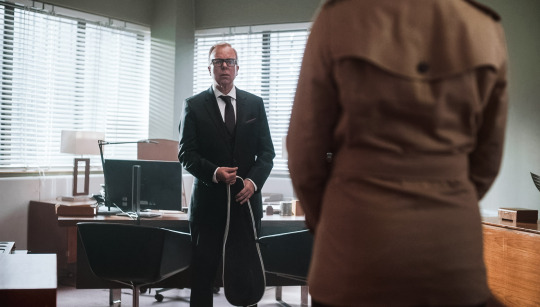
These characters start this point in the dialogue filmed from these camera angles. We have two very powerful and dominant characters face to face, but it’s Carolyn who starts asking first if he’s working for youknowwho, so, she gets the low angle first.

(I mean, he’s being literally framed thanks to this genius shot as the door closes)
Then a few seconds later...
“Are you, Carolyn?”
Low angle for Paul as well:
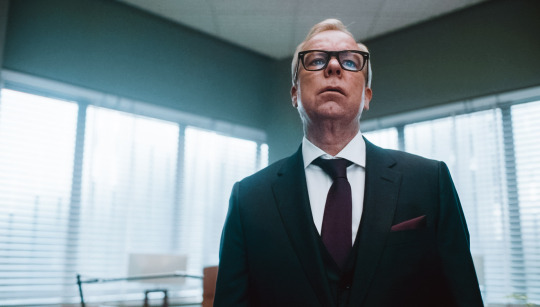
But then as we get this shot, the camera starts moving up and completely changes the angle for both characters.
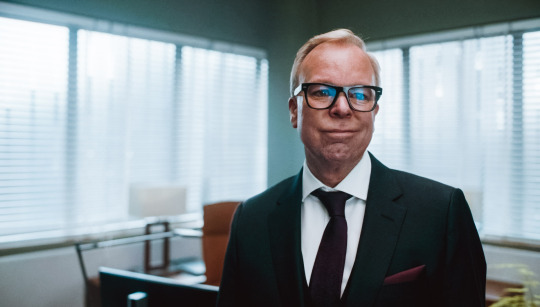
- Why on earth would you ask me that?
- Well, the same reason you asked me, because we don’t trust each other.
- Should I trust you?
- Heavens, no. None of us are to be trusted, that’s why we work here.
We got them in the same camera angle now.

“The Dutch angle” (or “dutch tilt”)
This is one of the types of camera angles that most emotion can add to the screen. Commonly used in thrillers and horror scenes, it gives an obvious discomfort feeling, showing that something in the scene is off, portraying a sense of psychological trauma, emotion and tension. It can bring us into the mental state of the character in that moment.
The angle of the camera can be described as being horizontal to the bottom of the shot's frame. The horizon isn’t leveled and is off by at least 30º degrees or more:
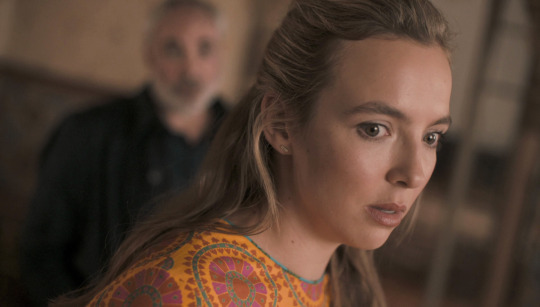

Overhead shots

In this analysis we’ve seen different camera angles and how it conveys a certain feeling from the characters to the audience.
We’ve seen how if we film a character from above it can be seen as inferiority. So, what happens if we take this type of shot to the extreme?
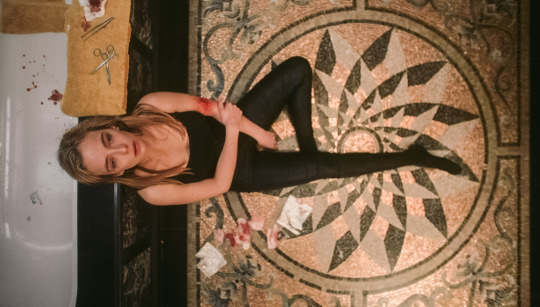
Remember how Villanelle was feeling at this point in the series. We could say this was the lowest we’ve seen this character.
An overhead shot (or birds eye view) is when the camera is placed above the subject. This type of camera shots are a perfect technique to show that the character feels that it has no way out of the situation he/she is in. It isolates the character.
“I’ve got to get out of here” “I don’t want to do this anymore”
On a final note, I’d like to talk about a type of camera angle that we have seen multiple times this season:
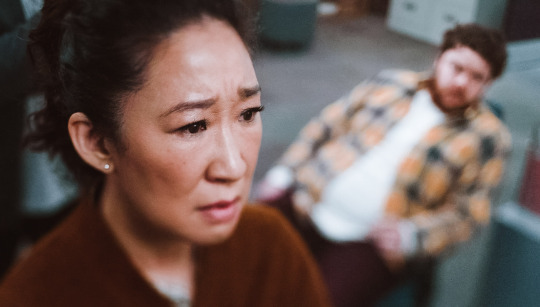
We’ve seen that filming a character from a high angle can make it seem vulnerable, inferior, making the audience understand that he/she is in a situation of distress. By also using a shallow depth of field (the distance between the nearest and furthest elements in a scene that appear to be “acceptably sharp” in an image) we intensify this feeling. As Killing Eve’s director of photography Tim Palmer said in a recent interview, this technique is used to metaforically get inside the brain of the character.
Remember the rule of thirds that I talked about in the previous post. If we place the subject where the air of the picture should be, it conveys a certain feeling of emotional disconnection or discomfort in a dialogue scene, right? In this camera shot all of this gets reinforced with this shallow depth of field:
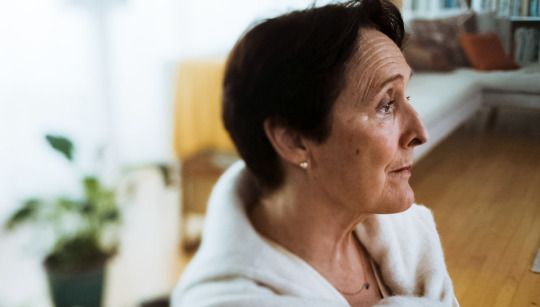
.
All original images belong to Killing Eve (BBC).
.
More photography analysis:
Rule of thirds
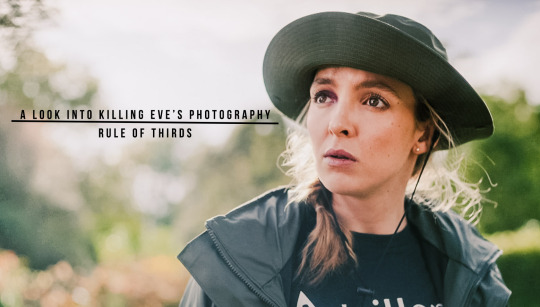
Leading lines

If you want to learn more about all of this:
Storytelling through all the filming elements:
https://www.youtube.com/watch?v=aE-6M7IbNSI
Depth of field:
https://www.photopills.com/articles/depth-of-field-guide
.
References:
https://wolfcrow.com/how-filmmakers-manipulate-our-emotions-using-camera-angles-and-movement/
#A look into Killing Eve’s S3 photography#let's learn photography with ke#killing eve photography#tv photography#killing eve cinematography#killing eve#ke#ke s3#villanelle#eve polastri#carolyn martens#konstantin#jodie comer#sandra oh#ke analysis#killing eve analysis#ke photography analysis
303 notes
·
View notes